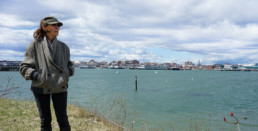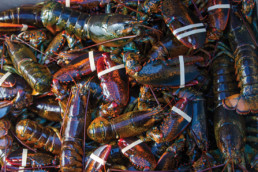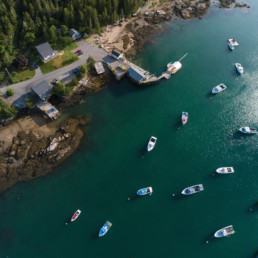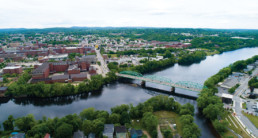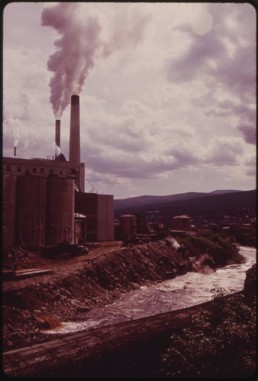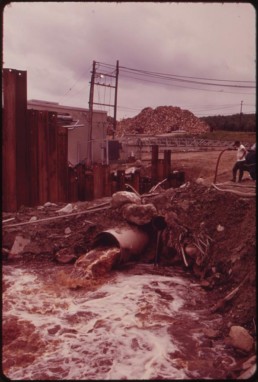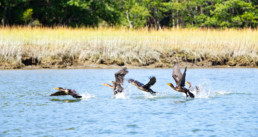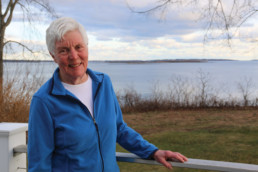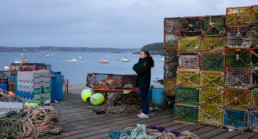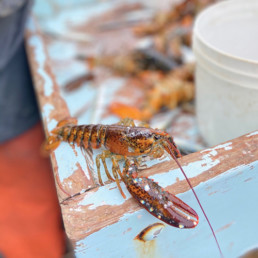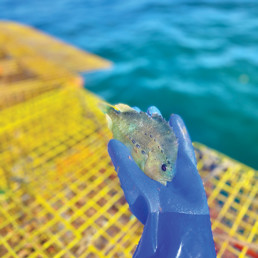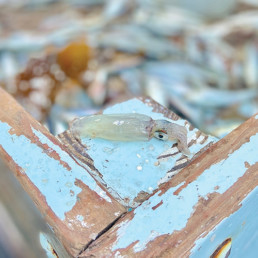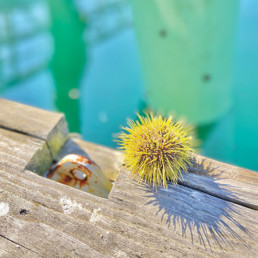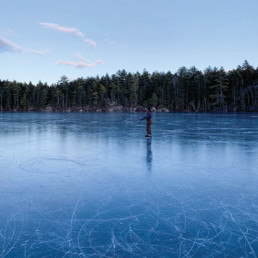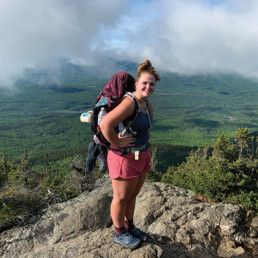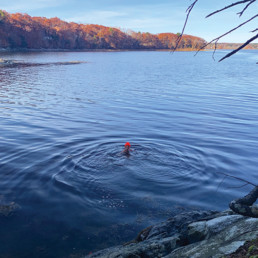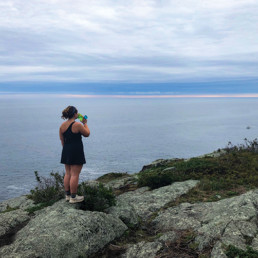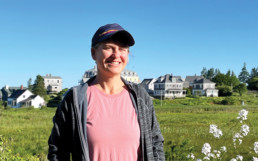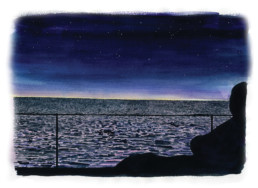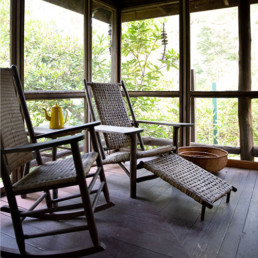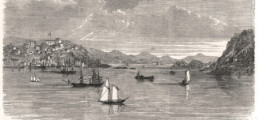Fisheries From 1973 to 2023 — How We Got Here
Robin Alden displays several issues of Commercial Fisheries News from throughout the decades.
FISHERIES FROM 1973 TO 2023 — How We Got Here
Former Marine Resources commissioner, fisheries editor reflects on changes
By Robin Alden
Photos by Jack Sullivan
I have been looking back at what fishing was like in 1973, the year I founded Commercial Fisheries News. The differences are stunning, even to someone like me who reported on those changes, sold ads for the new gear, was part of creating the new lobster laws in the 1990s, and tried to connect fishermen so that they could contribute to better science and better rules.
As the lobster fishery fights for its existence while confronted with new whale rules, declining prices, and biological indices—and stunning costs— looking back with that 50-year perspective can help clarify what is deeply important about lobstering and the strengths fishermen possess to meet a time of such profound change.
Fifty years ago, lobstermen were fishermen. If a lobsterman wanted to make more money than he could by lobstering, he could go tub trawling, gillnetting, or dragging for groundfish, scallops, and shrimp. There were herring to catch in stop seines, clams to dig, and mussels, especially once the state developed a market for that shellfish in the 1970s. Fishermen had the freedom to do that: Maine offered only three license types: lobster, commercial fishing, and commercial shellfishing. All were open entry.
Fishermen gained a lot of knowledge from having that versatility. Observations of a fisherman working in one fishery in an area gave him useful knowledge about other fisheries. Fifty years ago technology hadn’t overwhelmed the skill that comes from direct observation and a good memory; the skill, for example, of finding your traps in a fog mull without radar, Loran, GPS, or Olex sonar. Just a compass, running time, your flasher, and alertness—sound, smell, bird activity, the feel of the tide and the sea.
Fifty years ago, more than half the new lobster boats were wood, virtually all in the 30-foot to 36-foot range. There were only a few new fiberglass models on the market: Repco 30 and 37, and one hull each from Webber Cove, Jarvis Newman, and Bruno and Stillman. Most new lobster boats had gas engines, diesels only if the owner planned to pursue other fisheries, too. Traps were wood, mostly built or repaired in the shop each winter; heads were knit at home. Buoys were transitioning between wood and Spongex. The first Friendship Trap ad for wire traps showed up in Commercial Fisheries News in 1977.
The Coast Guard was going town-to-town in 1973, introducing the new Loran C technology. Only draggers had used Loran A at the time, so initially the change didn’t mean much to lobstermen, whose only electronics were a flasher and for some, a CB radio. Today’s fleet of lobster boats may look quaint to a tourist but there has been a technological explosion in the last 50 years. Contrast the boats of the 1970s with today’s wide, able 40-foot to 50-foot boats, complete with trap racks and 600- 800-plus horsepower clean diesels, with radar, GPS, sonars, radio, cell phone, and even computers aboard, fishing 800 wire traps delivered complete from the factory.

Copies of Commercial Fisheries News on Robin Alden’s kitchen table. Alden’s goal in starting the publication was to provide the foundation for understanding and collective action, melding different types of knowledge to allow Maine fishermen to fish forever.
There has also been an explosion of lobster. Most lobstermen today have only fished when landings have been increasing. Today’s Maine lobster fishery is catching more than six times the poundage being caught 50 years ago: increasing from 17 million to 109 million pounds. Why? Probably because of Maine’s good management that protects breeders and juveniles accompanied by climate-related changes in the Gulf. The price, until 2022, has kept up with inflation so that, in real terms, the Maine lobster fishery is bringing in over six times the money to coastal towns than it was in 1971. When has there ever been such a long run of good times in a fishery?
A third explosion occurred in government; the world of 50 years ago is unrecognizable today. When the Maine Department of Marine Resources (DMR) was created in the early 1970s out of the Department of Sea and Shore Fisheries, DMR was given rule-making power. Before that, fisheries rules seldom changed because virtually any changes had to go through the state legislature. At the federal level, the Clean Air Act, the Clean Water Act, the Marine Mammal Protection Act, and the Endangered Species Act all were enacted in the first four years of the 1970s. The Maine-New Hampshire border hadn’t been settled and it was almost another 15 years before the U.S.-Canadian boundary line went into effect. There were 200-250 foreign vessels fishing in the Gulf of Maine and on Georges Bank every month, including factory trawlers, purse seiners, mid-water trawlers, and others, each vessel hundreds of feet long. Fish stocks were depleted. A foreign captain complained that his tows had dropped to only five to 25 tons.
Maine lobstermen lobbied for a federal law to declare lobster a “Creature of the Continental Shelf ” and led the first leg in a “sail-in” to Washington with other East Coast fishermen. After years of outcry, the Magnuson Fishery Conservation and Management Act went into effect in 1977, putting in a 200- mile limit that excluded foreign boats.
The new law also created the New England Fishery Management Council. The council brought a type of management that had never existed before in New England: permit purchasing, individual transferrable quotas, quota leasing, and consolidation. Over time, the approach virtually eliminated Maine’s small-scale dragger, gillnet, and herring fleets, while allowing stocks of cod, haddock, and herring to plummet in the Gulf of Maine.
Lobstering avoided this fate as a result of dogged determination by Maine Lobstermen’s Association (MLA), led by Ed Blackmore of Stonington who was on the council. He achieved wins that we take for granted now—protection for V-notch and oversize lobsters and limits on dragging for lobsters. Each was a multi-year battle.
Especially critical was that lobster management outside three miles was removed from the council’s oversight and its federal management approach and transferred to Atlantic States Marine Fisheries Commission (ASMFC), a compact of East Coast states. Once in ASMFC, Maine state rules were extended out to 25 miles offshore. Along the way, the fishery added vents to traps and increased the minimum size of lobsters. Initially, many lobstermen vigorously opposed both measures.
In the mid-1990s Maine faced tremendous pressure to limit entry and put in a trap limit. Once again, with leadership from the MLA and many lobstermen, Maine went a different way. Entry was controlled through apprenticeship; owner-operator was put into law and Maine licenses couldn’t be traded. The trap limit was set at 1,200, to be gradually lowered to the current 800. Though many realized the number of traps was probably too large, at the time it was the lowest number that could pass the Maine legislature. Each zone council was given the right, which they have still today, to vote in a lower trap limit. Only Zone E has done so.
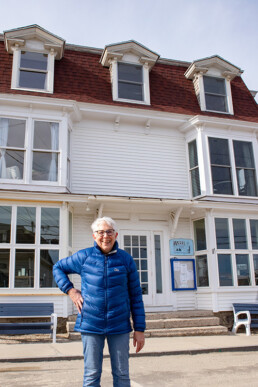
Alden stands in front of the former offices of Commercial Fisheries News in Stonington. The building is now occupied by a café.
Fifty years later, lobstermen now operate within a set of very complex rules. Gone is the anonymity of fishing without electronics, with new whale rules and trackers continuing the trend. Few lobstermen today are also fishermen. They have virtually no options to diversify in federal waters (outside three miles). State water fisheries cannot match the opportunities of the booming lobster fishery of the last 25 years.
Now, after 50 years of good times, lobstermen are facing daunting debt and an uncertain future in the face of climate change. All that is terrifying. Making a living in a wild-caught fishery is never guaranteed. This is the hard part of fishing, which some older fishermen remember well.
Yet, 30 years ago Maine lobstermen created and stood up for changes that have given them important resilience and a model for the future. They created something new in fishery management, based on what they wanted the business to look like. The result? Lobstering has prospered in communities the length of the Maine coast.
Without this vision, the explosion of both lobsters and technology over the last 50 years would have resulted in a consolidated, corporate lobster fishery based in a few big towns, with far fewer fishermen, and most working as employees, and our towns turned into tourist traps.
On top of all the rules that protect lobster biology, lobstermen stood up for and got these other principles passed into law in the 1990s:
- Owner-operator is key to keeping lobstering in coastal communities
- Apprentice-based entry to require a commitment to the business
- Across-the-board trap limits to ensure skill, not your bank account, determine how much you catch
- No transferable licenses or traps, to prevent consolidation and make it affordable for young people to start out
- Lobster management zones to keep lobstering opportunities in local communities
- Lobster zone councils to recognize area and fleet diversity and give lobstermen a voice about issues in their area, which differ along the coast.
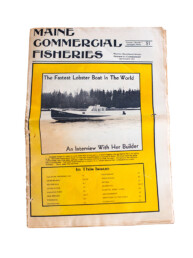
Volume 1, Number 1 of what was then called Maine Commercial Fisheries rolled off the press In September 1973.
None of this was easy—4,000 to 5,000 independent people, their crews and families didn’t, and won’t ever, speak as one. But as all of us enter this new world of climate-related changes in the Gulf of Maine, it’s worth acknowledging the creativity and leadership it took to get where we are.
The Gulf of Maine is a natural system, not just a place to steam over to go take lobster. Who can deny that our technology today has the ability to overwhelm any natural system? The problems don’t all come from the government; sometimes they come from us. As the ocean changes, we will all need to learn and adapt as we go—fishermen, scientists, and government.
The lobster fishery has always shown it can lead with humility and creativity, as well as with power and anger. It can chart an ecologically and community-centered future for those of us who fish.
Robin Alden founded Commercial Fisheries News, a Northeast regional trade newspaper in 1973. She served as commissioner of the Maine Department of Marine Resources under Gov. Angus King from 1995 to 1997. In 2003 she established Penobscot East Resource Center, now known as Maine Center for Coastal Fisheries. A version of this essay first appeared in Landings, the monthly newspaper of the Maine Lobstermen’s Association and is reprinted with permission and gratitude.
The Working Waterfront Wars
Karen Sanford on the shore in South Portland, looking westerly at Portland’s waterfront. Sanford was a leader in the effort to preserve working waterfront access after condominiums were built on a pier.
PHOTO: TOM GROENING
The Working Waterfront Wars
Condos on a Portland pier was the shot heard along the coast
By Tom Groening
Karen Sanford had a quiet life planned when she arrived in Portland in the mid-1980s. Earlier, while living in Seattle, she became politically active as that city’s waterfront faced transformation from a diverse, active maritime zone to one dominated by hotels and condos.
Sanford, who now lives in South Portland, moved into Portland’s West End and she remembers looking forward to becoming involved in book clubs and learning to cook lobster. But just as changes were afoot in the Pacific Northwest, developers had their eyes on Maine’s largest city. And she could not stand by and let the working waterfront disappear.
The shot heard along the coast was a condominium project on Central Wharf, later renamed Chandler’s Wharf. For the struggle to preserve access to the water for those who made a living there, it was a kind of Pearl Harbor moment.
The access was lost and remains so today.
“It was the premier pier on the waterfront,” Sanford remembers, with adjacent deep water, protection from prevailing winds, and businesses nearby that supported the fishing industry. There was one upside: it suddenly became easier to rally people to the cause. She remembers many people describing the impetus to oppose nonmarine development: “When I saw those condos…”
Sanford, in joining others who saw the threat, drew on her experience in Seattle, where a broad coalition formed to fight the encroachment of housing and hotels. Fishermen like Willis Spear became the face of the opposition, and powerfully spoke about what was at stake, she says, even recording radio ads.
Sanford and others worked to get a referendum on the city ballot to stop further housing and hotels, and in May 1987, residents voted by a 2-1 ratio to block nonmarine development on the waterfront. It was a landmark victory, but 35 years later, the struggle continues in places like Boothbay Harbor, Rockland, and Southwest Harbor, waterfronts that may have seemed safe from threats back then.
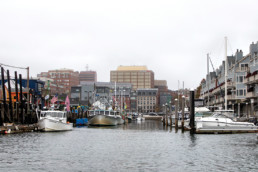
Central Wharf, at right, was transformed from a fishing pier to a condominium development in the mid-1980s, galvanizing opposition to further nonmarine development on Portland’s waterfront.
PHOTO: JACK SULLIVAN
The allure of the condo project wasn’t difficult to understand—people with the means to do so like to live on or near the water. But ironically, the activity of fishing boats they find charming becomes threatened by the transformation.
A report analyzing Portland’s changing waterfront published in 1988 by John Ferland of the University of Rhode Island articulated the dynamic it described as inevitable: “Change [is] caused by whirlwind development flowing north from the eastern megalopolis. While it is too early to draw conclusions on the fate of Maine’s coastline, it is interesting to keep in mind a rule of thumb espoused by one-time State Planning Office economist Lloyd Irland: ‘People invest in attractive places until they are no longer attractive.’”
Ferland, writing 34 years ago, identified the precursor to this investment: “The pumping of millions of taxpayer dollars into economically depressed maritime industries combined with allowing market forces to spur nonmarine development along a small section of the waterfront.”
The succession that Portland witnessed has or will play out elsewhere. Waterfront industry declines, because it either goes overseas or locates inland, no longer able to dump waste into the sea. Artists and craftspeople rent some of the vacant space as inexpensive studios, then galleries open, drawing browsers and buyers. Restaurants and pubs, hoping to extract spending from these people, follow.
It’s not the worst fate for a city like Portland, but people like Sanford try to champion the victims in this transformation.
“It’s really about what’s right,” she asserts, mindful that battles over protecting working waterfront access will never end. “How do we take care of our natural resources? There’s no more important natural resource than our connection to the sea.”
Ferland offered a prediction back in 1988: “Portland’s experience will be useful for other communities, either for successes to be emulated or failures to be avoided.”
Once access points are gone, they do not come back,” was one of several blunt statements included in a report issued in late 2021, researched and compiled by Merritt Carey, a seasonal resident of Tenants Harbor. The report, “The Critical Nature of Maine’s Working Waterfronts and Access to the Shore,” was commissioned by the Island Institute.
There is much at stake, Carey argues, with the lobster industry alone generating more than $1 billion in economic activity, according to a 2018 Colby College study. “Considerable growth” in aquaculture, coupled with a healthy scallop fishery, and the less visible but steady harvests of groundfish, clams, seaweed, and worms, means pressure by users will not abate, she writes.
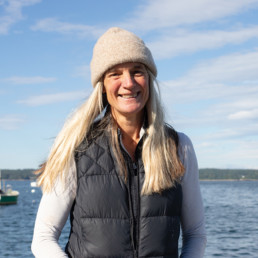
It’s not just fishermen and ocean farmers who benefit from access.
“Those who flock to our shores to consume lobsters and steamers, to visit our oyster trail, who stand mesmerized as they watch fishermen unload their catch” also benefit from the working waterfront, Carey writes.
“Any way you measure, whether raw economic data, heritage and history, or community, Maine’s working waterfront and our ability to earn a living on the water is integral to who we are, and who we should be,” the report asserts.
Carey concludes that rather than defending access harbor by harbor, a statewide action plan with an agency with teeth is needed.
Boothbay Harbor has been characterized by tourism-based businesses for generations, but a recent development threatened fishing access. An older, shorefront motel had ceased operating, and a proposal was made by a wealthy newer resident to purchase and demolish the building and rezone the motel property and more of the shore to allow for retail and other uses. That part of the shore included a privately owned working waterfront access point.
More than $5.5 million was raised privately to purchase the property under the auspices of a working waterfront preservation nonprofit. That group plans a waterfront park and “working waterfront hub” on the parcel. Had the original zoning change proposal been approved, fishermen would have had to scramble for access.
The Boothbay Harbor story highlights a key component of the threat: much of the access to the water is privately owned. These privately owned access points “have long provided overland access to the shore … on a handshake,” Carey notes in her report. When these properties are sold to those with no relationship with users, access is lost.
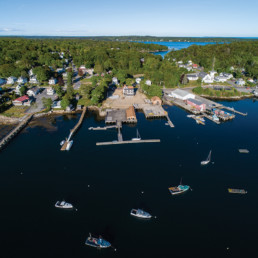
The former site of Cap’n Fish’s Motel on the east side of Boothbay Harbor; the motel closed in 2019, but the community gathered to create Boothbay Harbor Waterfront Preservation, the nonprofit organization that is funding the construction of a public park in the 1.4 acre lot, which will preserve working waterfront access.
PHOTO: JACK SULLIVAN
Carey’s report also notes the domino effect that follows loss of access:
“A single clammer without access…will use an airboat. The noise will likely lead to bad relations with neighbors and waterfront owners…[which] leads to competition for space and resources.” What follows are crowded boat launches and wharves, she writes.
Another pressure comes as out-of-staters decide to buy a home near the shore. Several years ago, the Maine Sea Grant program at the University of Maine developed brochures to be distributed to real estate agents in Harpswell and Jonesport-Beals, both active fishing ports. The brochures were to be given to would-be buyers, reminding them that the picturesque lobster boats bobbing at anchor during cocktail hour come with some less-charming realities—trucks passing through at 4 a.m., diesel boat engines revving a little later, and the stink of rotting bait on the pier next to pleasure boats.
With COVID bringing even more interest in the Maine coast from out-of-state house buyers—as much as 25 percent of sales in 2021—traditional working waterfronts may face more opposition.
The coast-wide fight to save the working waterfront won a substantial victory that came in a change to the state’s constitution. Maine’s property tax system, like that of most states, assesses taxes based on the real estate value of a property. This means a waterfront lot—perhaps including an unpaved parking area and a small wharf—on which a hotel might be built was assessed at the higher, not current use value. The higher property tax bill tends to spur the owner to sell or develop.
In November 2005, Mainers approved a constitutional amendment dictating that waterfront properties be taxed at the value of their current use. It passed with 72% of voters supporting the measure.
But that didn’t eliminate threats, and work continues on other fronts.
Sam Belknap’s family has owned and operated a commercial fishing wharf in Round Pond on the Pemaquid Peninsula since the early 1950s. His grandfather purchased it then with some trepidation, Belknap said, because “at that time, no one really recognized the value of working waterfronts.”
Belknap, a senior community development officer with the Island Institute who focuses on working waterfront preservation, says the threat today is the same as it was in the mid-1980s: “Development for nonmarine uses.”
The pandemic has accelerated this development, he says. “Maine has become a safe haven, a place of refuge and respite.” There is another component to this pressure, though. “Now you layer the real threat of climate change on top of that.”
Aquaculture is growing, in part as a hedge against uncertainty in the lobster fishery, which is impacted by warming waters. Federal concern about right whales comes in part because the mammals’ food source is moving, again because of warming waters.
And a final worry for the fishing industry is the push to develop offshore wind turbines as a means of moving away from fossil fuels.

Combined, Belknap says, “they are chronic stressors.”
Rather than a wave of development pressure crashing up the coast, “Now, it’s popped up from York to Eastport, in discrete events.”
The Island Institute is committed, he added, to preserving working waterfront access because it serves as the backbone of so many island and coastal communities.
The state’s Land for Maine’s Future Fund now identifies working waterfronts as worthy of preserving and it pays for, through outright purchase or deed restrictions, maintaining access. The statewide nonprofit Maine Coast Heritage Trust also has added working waterfronts to its preservation focus. Both changes represent a substantive evolution in mission, reflecting the urgency.
In Portland, a hotel, restaurant, and retail proposal for another part of the waterfront stirred opposition quickly in 2019. A Waterfront Alliance formed to advocate for fishing and other interests, and that group continues to meet and monitor waterfront matters.
But even as awareness of the fragility of waterfront access has increased, policy makers have also begun seeing that blanket fixes are not always appropriate. In Portland, for example, some parts of the waterfront were zoned for marine-related or marine-dependent businesses. But how many rope, buoy, and trap shops can make enough to pay the rent? In recent years, some of those restrictions have been eased.
But Portland continues to be a battleground, Sanford and others believe, as hotels and restaurants proliferate. In an op-ed published in the Portland Press Herald in 2017 on the 30th anniversary of the referendum vote, Sanford issued her report card, giving low grades on the city’s “hot pursuit of a huge hotel on the Maine State Pier,” one of only four that are publicly owned. Though it failed to come to fruition, “Hotel dreams die hard, even in already crowded hotel markets,” she warned.
She also criticized the development of the former Cumberland Cold Storage building “into 98,000 square feet of law offices and other non-marine businesses,” and the city approving the former Portland Co. site “into a private, formulaic Faneuil Hall-style hotel, condo, and retail development.”
Sanford gave high marks to the thriving Eimskip-operated shipping port and, farther west, Portland Yacht Services.
Today, Sanford recommends the city hit the pause button for 20 years, if only to see what climate change brings.
“There have to be idle places along the water, sometimes for decades,” she says, “like fallow land on a farm.” Predicting future waterfront-based activity is difficult, she continues, and cites the frenetic pace at which ships were built in Portland and South Portland when the U.S. entered World War II.
“It could be a completely different waterfront in 50 years.”
Tom Groening is editor of Island Journal and The Working Waterfront.
The Long Journey from Boat to Plate
The Long Journey from Boat to Plate
A complex supply chain, heavy on infrastructure, delivers lobster
Story by Laurie Shreiber
Photos by Jack Sullivan
It’s 2:30 in the morning and the wharf staff at Fifield Lobster Company in Stonington is preparing for the arrival of about 40 commercial fishing boats in the next few hours, with the vessels landing just long enough to load up on bait and fuel.
The captains and their crews will then head out for a day of hauling. Most work closer to shore and return with loads of lobster between noon and 4 p.m. The larger boats return from farther offshore in the evening.
The comings and goings might seem hectic but are well-organized.
“The bulk of our fishermen usually start setting their traps in May,” said the company’s co-owner, Travis Fifield. “The inshore guys run through the end of December. We have seven or eight offshore boats. They’ll go all winter.”
But what happens to all those lobsters coming to the wharf, day in and day out? At Fifield’s wharf, that amounts to over a million pounds per season. Throughout the state, it was 96.6 million pounds in 2020. That’s a lot of creatures hauled live from their homey ocean bottom to an alien terrestrial setting in a fishery whose most important mission is remarkable given the global distances many travel: keep them alive and healthy.
“There’s a lot of work that goes into that,” said Annie Tselikis, executive director of the Maine Lobster Dealers’ Association in South Portland. “It’s not just a matter of moving lobster quickly. It’s also about doing right by the lobsters themselves. They are sensitive animals.”
To accomplish the job, it’s important to remember that Maine’s lobster fishery isn’t just the fishermen. It’s a wide-ranging network of buyers, distributors, and processors that supply a diverse market—grocery stores, restaurants, hotels, cruise ships, direct-to-consumer—spanning everything from tiny tourist enclaves to major metropolitan regions around the world.
Lobster journeys begin when they’re plucked from traps, placed in holding tanks on boats, and taken to buying stations. The station could belong to a private company or a lobster cooperative. Or it might be a public landing, where buyers stand ready with refrigerated trucks.
After tying up, fishermen unload the undifferentiated lobsters into standardized plastic crates.
“That’s the first point of receiving them at the wharf or the co-op or the buying station,” said Tselikis, noting the terms are generally interchangeable. “At that stage, fishermen get paid and are done with the product.”
The crates go onto refrigerated trucks for transport either to live-lobster distributors or to processors.
Those going into the live system are graded for shell quality and size.
“If I’m going to ship lobster to South Korea, I’m looking for high-quality, lively, hard-shell lobsters, because that lobster will be the most likely to survive a 30-hour journey from Portland to Seoul,” she said.
Some markets request certain sizes. For example, Spain prefers smaller animals; Asia prefers larger. The industry must be ready any time of year. For that reason, Maine is closely connected to eastern Canada, whose winter fishing season kicks in just when Maine’s is winding down, providing dealers with a plentiful source when demand is still high, particularly for holidays such as Christmas and Chinese New Year.
Lobsters depart Maine loaded onto pallets by the thousands of pounds and delivered by truck or plane.
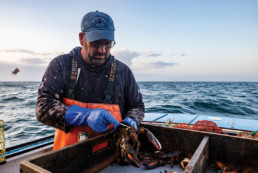
A lobsterman measures his catch to ensure it’s legal for market. Lobsters must have a carapace 3.25-5 inches and not be an egg bearing female in order to be sold at the dock.
If you’re flying to a place like Hong Kong or Dubai, not only is your luggage in the belly of the plane, but so are Maine lobsters,” said Tselikis.
The strategy is a bit different for lobsters going into the value-added processing stream.
“It’s a volume game,” said Tselikis. “We’re looking for very good quality lobster with high meat yields to meet the demands of processing plants.”
Working with one of the most expensive proteins on the planet, the industry is constantly investing in more efficient ways to deliver product, whether it’s a specific live lobster grade or picked meat or frozen tails.
“For example, cruise ships buy frozen tails, not live lobster,” she said. “Tails are easy to put on a buffet. But food trucks and quick-service restaurants look for lobster meat for their lobster tacos or lobster pasta. Live lobster goes to white tablecloth restaurants or to lobster shacks.”
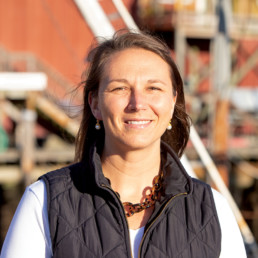
Annie Tselikis, executive director of the Maine Lobster Dealers’ Association
Constant innovation of technologies for functions such as rapid freezing, high-pressure processing, and water-quality sensors for live lobster holding tanks has been essential to the success of processing and distribution. The supply chain is also a major employer. According to a 2017 study conducted by Colby College for the MLDA, about 6,000 people operate the supply chain in a variety of roles—wharf workers, buyers, production, meat-pickers, sales, truck drivers, finance and administration, and quality assurance.
Passersby might never notice these businesses, which are often pretty nondescript on the outside.
“There are facilities in Maine holding 100,000 to 300,000 pounds of live lobster at any given time,” said Tselikis. “There’s much more to this industry than, I think, the general consumer understands, because it’s largely invisible.”
But substantial infrastructure is needed to support the system.
“The most valuable part is waterfront access, which is the part that a lot of people don’t consider to be a service,” said Fifield. “If we didn’t provide it, who would?”
Then there’s infrastructure such as fuel tanks, freezers, forklifts, hydraulic hoists, skiffs, floats, and moorings. All require regular maintenance and repairs. At Fifield’s operation, that can amount to $100,000 per year.
Power and water are also big expenses.
“We require water for lobster processing and for holding facilities,” said Tselikis. “Power is critical because we’re dealing with major refrigeration units for water systems, storage, ice making, and processing infrastructure.”
Other major costs include processing equipment, packaging designed for every specific product and market, trucking, cold storage facility usage, ongoing maintenance costs, and payroll.
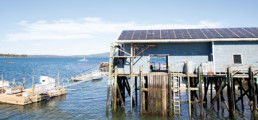
The Cranberry Isles Co-op placed solar panels on all four of its buildings, the largest of which is on the bait shed.
The logistics of running a buying station on an island are a bit trickier. At the Cranberry Isles Fishermen’s Co-op, product is loaded onto two boats owned by the co-op and taken to the mainland, where buyer trucks await, said General Manager Marc Nighman.
“We have a deal with a dock on the mainland to use their wharf to load the trucks, so that’s an added expense to being on an island,” said Nighman.
Pricing throughout the supply chain is determined by supply and demand, with expenses such as labor and storage factored in.
“Every year is different,” Nighman said. “I talk to other co-ops and say, ‘What are you getting from your buyers?’ With all the social media now, if somebody across the pond is getting a dime more than me, I know it and I call my dealer and say, ‘Hey, they’re giving him a dime more.’ They’ll say, ‘It’s probably an isolated thing.’ I say, ‘The thing is, it’s isolated in my backyard.’ If I sell [at a dime less] to you today, I’ll hear it from my fishermen tomorrow—or more likely today because they’ll communicate it over the radio.’ Usually the buyers are pretty good about it.”
Such day-to-day interactions are the unseen part of the industry.
“People have romanticized the fishing industry for generations,” said Tselikis. “But one thing that’s so motivating for me is how the product gets to market and how you build those markets. I’ve been coming up in the industry for the last 15 years. Our volume and global market and demand have increased rapidly. Lobster companies are very good at getting this product to customers around the world.”
Laurie Schreiber has been covering Maine fisheries for 30 years, writing for publications such as Mainebiz, Maine Boats, Homes & Harbors, and The Working Waterfront. She is also the author of Boatbuilding on Mount Desert Island. She lives on MDI.
Fifty Years of Cleaner Water
The site of the Continental Mill in Lewiston on the Androscoggin River as seen from Auburn, the western bank. Textile mills like the ones in Lewiston as well as paper mills upstream contributed significantly to the Androscoggin’s degradation in the 1950s and 60s.
PHOTO: JACK SULLIVAN
Fifty Years of Cleaner Water
Thanks to a Maine senator, federal law protects our bays, rivers, and lakes
By Frances Mize
Fifty years ago, Maine Sen. Edmund Muskie concluded a decade-long fight to pass legislation to protect—and improve—the quality of the nation’s fresh and salt waters. Even though then-President Richard Nixon worked to stop the bill, on Oct. 18, 1972, the Clean Water Act became law.
Muskie (1914-1996), who grew up in Rumford on the banks of the Androscoggin River, had watched as the river slowly choked on discharge from the paper mills and other industries that had built along its shores. The Androscoggin was especially attractive to industry because of the unmatched energy potential of the river’s 1,500-foot vertical drop from its source in the Rangeley Lakes to its outlet in Merrymeeting Bay near Brunswick.
For most of the 20th century, the Androscoggin was legendary for its polluted state. White houses along its banks turned black and the paint blistered. Jewelers battled the effects of sulfite, which turned rings, watches, and necklaces black for those who lived nearby. Children sold clothespins in the Lewiston-Auburn area to be worn on the nose while crossing the bridge to block the unbearable odor. Fish died in massive swaths and the river literally burned.
And the problem wasn’t limited to the Androscoggin. Other rivers across Maine, like the Presumpscot and Penobscot, also had become the smelly poster children for America’s dirty water problem. Before the Clean Water Act, water pollution was discussed in terms of how much discharge a body of water could withstand. The Clean Water Act mandated complete elimination of discharge by 1985.
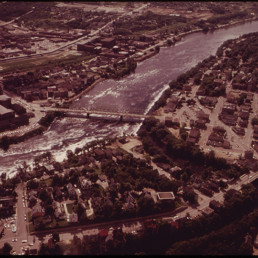
The view above in 1973, one year after the Clean Water Act.
PHOTO: CHARLES STEINHACKER
Water bodies across the state now face new challenges. The next 50 years of water quality is tied to the state of wastewater treatment capacity. Wastewater treatment facilities—which didn’t exist before the Clean Water Act, and since its passage have played a substantial role in cleaning up Maine’s waters—now pose a threat of their own.
The treatment plants process water that contains nitrogen and phosphorus from human waste, food, and certain soaps and detergents. Around 34 billion gallons of wastewater move through America’s plants each day, and once the water is cleaned to the standards set and monitored by state and federal officials, it is typically released into some local body of water. The Clean Water Act authorized federal funding for the construction of municipal sewage treatment plants, with money distributed to cities and towns so that they could better comply with the new water quality expectations.
But some of the plants are able to remove these chemicals better than others, so the processing isn’t always done to completion and this discharge can and does become a source of chemical pollution.
Photographer Charles Steinhacker was hired by the Environmental Protection Agency as part of its Documerica Project. The goal was to capture images of environmental problems in the United States. This series of images from 1973 depicts the pollution entering the Androscoggin River.
Elimination System (NPDES), polluters today are in consent agreements with EPA. NPDES permits are licenses that allow facilities to dump up to a certain amount of a pollutant into a water body. Permits may also authorize facilities to process, incinerate, or make use of sewage sludge.
Just this year, residents in Fairfield learned that high levels of PFAS chemical compounds have been leaching into their groundwater for decades; wells, streams, and even soil were revealed to be dangerously contaminated. These “forever chemicals,” which are widely used and don’t naturally break down, settle in the sludge at the bottom of wastewater treatment plants.
Under NPDES oversight, the sludge is sometimes used as a soil fertilizer and spread over agricultural fields. According to the Maine Department of Environmental Protection, the sludge in Fairfield came from the Kennebec Sanitary Treatment District, which was collecting industrial waste from the Huhtamaki paper packaging mill in Waterville. However, DEP officials say that the company was well within its right to spread it and in compliance with state permits.
Many treatment plants in Maine are fed by old piping—some are made of clay and date back over a hundred years—which can allow other pollutants to leach through. Peter Didisheim, senior director of advocacy for the Natural Resources Council of Maine, says there’s been about a $1 billion backlog in funding from the state that should be going towards upgrade, a delay made more dangerous with time as increased storm activity and rising tides threaten Maine’s many treatment plants that sit at sea level.
Extreme weather events can overwhelm a plant and discharge polluted, untreated water. It’s likely that some of these plants will either have to be rebuilt or moved.
“Several of the dischargers, like Portland and Bangor right now, are under consent agreements with the EPA that they’re in violation of the Clean Water Act,” explained Didisheim.
But they’re in an impossible situation. Where’s the money going to come from to address the deficiencies in their system?
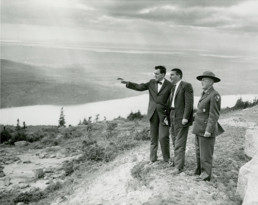
Maine Senator Edmund S. Muskie, left, with Secretary of the Interior Stewart Udall and an unidentified National Park Service employee at Cadillac Mountain in Acadia National Park in 1962.
Funding helps when it can be secured—2018 saw a $12 million upgrade to the 36-year-old aeration system at the East End Wastewater Treatment Facility in Portland. Modernizing the system meant the plant could continue to do its job during dramatic weather events, and it recently stood up to one of the wettest Octobers Maine has ever had.
In the last four years, the East End facility has reduced its nitrogen output by about 1.5 million pounds.
Casco Bay Waterkeeper Ivy Frignoca is also concerned about the impact of rising sea level on old treatment plants, and thinks the Clean Water Act should be modified so that it is more forward thinking.
“When the regulations were written to implement the Clean Water Act, we weren’t thinking about climate change. Everything was decided based on the science that was known then,” said Frignoca. “Now we have to be thinking about the fact that our waters aren’t just warmer than a decade ago, they’re going to continue to warm.”
Federal infrastructure money from the Build Back Better effort and the American Rescue Plan will be helpful. Frignoca is also hopeful that the Maine Won’t Wait climate action plan, which calls for updating many of the current coastal land use regulations, will provide support from a more local level.
“All of this is quite exciting to those of us who have been eager to achieve the original goal of the Clean Water Act, which is to eliminate altogether the discharge of pollutants into our rivers, streams, and coastal waters,” said Didisheim.
The time for a more hardline approach to pollution regulation might be upon us as we enter into an ever-changing situation with our climate. Just as it was in Muskie’s day, harm to water is invisible until it’s too late. If we don’t act soon, we might end up walking around again with clothespins on our noses.
Frances Mize, originally from Atlanta, is a recent graduate of Dartmouth College with a bachelor’s degree in English and a minor in anthropology. She recently began work as a reporter at a newspaper serving the Upper Valley region of northern New Hampshire and Vermont. She also has written for The Working Waterfront.
The 'Undeclared War' on the Reviled Cormorant
The ‘Undeclared War’ on the Reviled Cormorant
Research dispels myths about their threat to sea life
By Dana Wilde
One summer morning in about 1963, I was fooling around in my 14-foot flat-bottomed punt near the beach on Mackerel Cove. Probably I was wrestling as usual with the oversized 15-horse Johnson outboard that was attached with clamps, twine, and hope to the punt’s frail transom, I can’t remember exactly.
The water was flat calm, so smooth and dark you might be able to walk on it. The sun was not yet high enough to be beating down, just illuminating the sea-fragrant, breathless island air. Boats motionless on their moorings. Distant clattering of lobster cars being handled. Birds, a few gulls floating serenely, obliviously nearby.
The rasp of an outboard approached. A fisherman in worn yellow slicker overalls, standing in the stern of his maybe 16-foot boat holding the outboard tiller-throttle angle-up, was cutting mathematically smooth waves through the water, coming in my direction.
I revered the lobstermen. This guy was strapping big, maybe 30 years old, an ancient mariner to ten-year-old me.
Fifteen or 20 feet from where I was floating, he cut his boat hard to starboard, throwing waves in my direction. But this was not about me. The cut ran him up beside one of the gulls, surprising it. Suddenly producing a bait pick in his other gloved hand, he stabbed down hard three or four times as he glided past. I saw the gull go head down in the water under the blows. Feathers and blood flew up. The fisherman accelerated away back up cove.
It was a long time before I had any idea what this violence might be about.
It was illegal to kill seagulls, as we colloquially referred to the great black-backed and herring gulls common along Maine’s coast. I knew that at age ten.
Much later I learned it was the federal Migratory Bird Act of 1918 that protected them. It was enacted because conservationists were already, more than a century ago, gravely concerned about human effects on wild bird populations. Great auks and passenger pigeons had been hunted to extinction, largely for fun. Gulls themselves were almost wiped out along the Atlantic coast by the late 19th century.
To me gulls seemed like dolts of the islands—ungainly and sour-looking perched, lurking stalkers in flight. They were known thieves (in the summer of 2019 a gull was videoed snatching a lobster roll from a tourist’s hand at an eatery near Nubble Light), and this was one reason some fishermen disliked them.
This fisherman impulsively (apparently) killing one gull would do nothing to reduce the competition for whatever fish or shellfish he thought gulls were stealing from his livelihood. So I kind of think it went deeper than that. Generationally deeper, maybe. I learned later that there were birds some people did not just dislike, but actively wished exterminated.
Cormorants, to be precise.
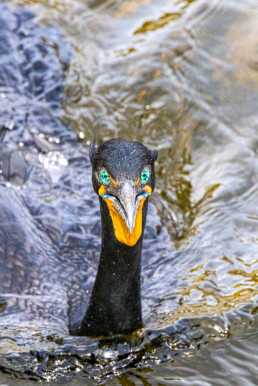
PHOTO:MICHAEL GIGLIA
These are the dark-colored low-riders of the water the fishermen call shag. They arrow in straight lines close to the surface, sometimes in formation, and dive like missiles for fish, going as deep as 60 feet or more. Their feathers do not shed water the way most birds’ do, and so cormorants are often seen perched on a buoy or an outcrop of rock with wings spread to dry.
Cormorant species live near water practically everywhere in the world. In the Gulf of Maine two are common, or have been—the double-crested cormorant (Nannopterum auritum) and the great cormorant (Phalacrocorax carbo). The double-crested cormorant has an orange throat pouch; the great cormorant is larger and has a white neck patch.
Along the Maine coast in winter, double-crested cormorants migrate south, while great cormorants migrate in from north. Double-crested cormorant populations are doing well, after ups and downs in the 20th century, and they’re found near fresh and salt water over much of North America.
Great cormorants’ North American populations inhabit mainly the East Coast from the Carolinas to Maritime Canada and Greenland. Their numbers are stable overall. But while a recent Audubon Christmas count logged 11 in the Pemaquid area, steep declines have been noticed in Maine recently; breeding populations of great cormorants are on Maine’s threatened species list. What’s causing the decline is uncertain; one possibility is the swelling numbers of bald eagles, which prey on the young birds.
Cormorants nest in colonies on rocky ground or in treetops. One of the things people have against them is that their feces accumulating around nesting sites can kill trees and other vegetation and are thought to foul water. They eat basically whatever is readily available to catch, including crustaceans, insects, and amphibians, but mostly fish.
And this is where the friction arises. For hundreds of years at least, cormorants have been viewed as a threat to human fishing activities.
“Black water rats,” one old-timer in Owls Head remarked to Richard J. King, author of The Devil’s Cormorant: A Natural History. “Good for nothing but bait.”
The old-timer was voicing a disdain so old it had become superstitious: “See one cross your bow and a storm’s on the way.”
New England’s double-crested cormorants were targeted as early as colonial times. Thinking their fishing livelihood was at stake, settlers set about getting rid of them. King finds Massachusetts colonist William Wood complaining in 1634 that cormorants “destroy abundance of small fish.”
Killed copiously for food, feathers, and sport, by the early 1800s cormorants had been extirpated from the region. Then, amid turn of the century conservation efforts, they were nesting in Maine again by the mid-1920s. They continued to be viewed as a threat, and a kind of undeclared war ensued involving fishermen, governments, biologists, and the cormorants.
In the 1930s a young University of Maine wildlife biologist, Howard Mendall, decided to find out if he could sort out what was and wasn’t true in the cormorant lore. His mission included spending days and nights collecting data on Marblehead Island, a nesting site just south of Owls Head. His eventual monograph, The Home-life and Economic Status of the Double-crested Cormorant, concludes (as King points out): “the [cormorant] is fully deserving of our protection and … except in scattered, local instances, it is largely neutral if not actually beneficial in its relationship to man.”
But Mendall’s research did not quell age-old suspicion. In the 1940s and ’50s, systematic efforts to reduce cormorant populations were in motion. Methods included culling birds by shooting them with .22 rifles and by egg-oiling, in which vegetable oil is sprayed on eggs, causing asphyxiation and reducing hatching success. Between 1944 and 1953, 188,000 eggs were oiled along the New England coast.
It didn’t really work. Despite deliberate efforts to kill them and the harmful effects of pesticides such as DDT, breeding populations of double-crested cormorants persisted. From the 1970s through the 1990s, as the use of pesticides came under some measure of control and the 1972 amendment to the U.S.’s Migratory Bird Treaty with Mexico specifically protected double-crested cormorants, their numbers increased.
Meanwhile, harvestable fish species were declining noticeably by the mid-1960s. Birds were taking Atlantic salmon smolts in large numbers around restoration-project hatcheries. Cormorants took the brunt of the blame.
Studies were undertaken to determine whether and how double-crested cormorant populations should be managed to protect fisheries. In general the studies try to find out what the birds eat by analyzing the contents of their stomachs, regurgitations, and feces, as well as making direct observations of their fishing behaviors.
Many studies, such as one conducted by a University of Maine team in the mid-1990s, more or less corroborate Mendall’s finding that cormorants do not take large commercial fish in undue numbers, and that overall the birds probably do not harm wild fish populations, and may even benefit local marine ecosystems. They do damage vegetation.
So with no research showing definitively whether negative effects outweigh positive, or positive effects outweigh negative, efforts to suppress double-crested cormorant populations rolled on into the 21st century.
King reports hundreds of thousands of double-crested cormorants and their eggs were destroyed in the 2000s in North America. Eggs were oiled, hundreds of birds were shot annually. Non-lethal harassment programs to disrupt nesting were also used, involving scarecrows (not too effective), throwing stones, lasers, and firecrackers.
A study from the mid-2000s found harassment of cormorants at nesting sites on Narraguagus Bay did result in reducing the number of smolts lost from Atlantic salmon restoration projects in the area. Birds find the pickings easy around dams.
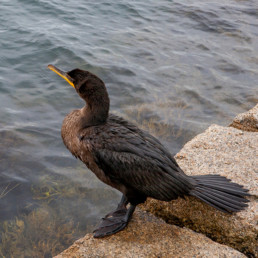
PHOTO: JACK SULLIVAN
Whether cormorants have any significant overall impact on harvests of wild fish is not clear. But the common wisdom, handed down for centuries, is that they do.
In Europe and North America, anyway. In parts of China and Japan, cormorants for centuries have been trained to catch fish, return to their human handlers, and regurgitate the fish whole, similar to the way falcons are trained. In those places cormorants are revered and using them to fish may have been brought from Asia to Europe around 500 years ago.
King James I’s enjoyment of cormorant fishing, though, seems to be an exception to an age-old prejudice. Milton in Paradise Lost describes Satan sitting on the Tree of Life “like a Cormorant … devising death / To them who lived” after sneaking into Eden. One of Shakespeare’s characters refers to the Trojan war in its voracity as “this cormorant war.” Chaucer speaks of the cormorant burning with gluttony.
Wildlife biologist Linda Wires traces what she calls the persecution of cormorants back to the biblical book of Isaiah. King observes in his book that even naturalists, disgruntled by damaged island vegetation, vilify cormorants and push for control measures. Some sportsmen have called for double-crested cormorants to be exterminated.
King tells the story of a group of sport fishermen on Lake Ontario in upstate New York organizing an activist group, Concerned Citizens for Cormorant Control. Convinced the cormorants were wrecking their sport fishing industry and fed up with complex regulations that already included studies, culling projects, and permits to shoot, they one summer night in 1998 gathered in boats, motored on the flat-calm lake to the cormorants’ nesting island, and slaughtered more than 20,000 birds, by their own count. They eventually were caught and fined, but long afterward remained unrepentant, according to King. They believed they were doing the right thing.
This is some deep-seated resentment, if not outright hatred. It rides the wake of centuries of learned prejudice. Whether the cormorants really have significant adverse effects on fish is almost as irrelevant as the research that disagrees about it. People learn to dislike cormorants, the feeling carries forward, accumulates over time, soaks into everyday life and lore, and becomes as hard to let go as superstition.
This is how prejudice works.
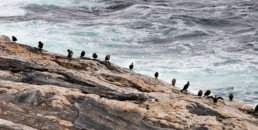
PHOTO: JACK SULLIVAN
I imagine the Bailey Island fisherman’s attack on the gull nearly 60 years ago was probably born of age-old, generational resentment. His father and grandfather, I’m thinking, may have disliked thieving gulls, like their fathers and grandfathers from the 19th and 18th centuries. He absorbed the common wisdom from back that far, the way we all absorb our moral values. His anchor was set. Gulls needed to be got rid of. So for the culling of black water rats, and everything else we learn early on to despise.
Not everyone detests cormorants, of course. When silent squadrons of two or three angle along with Doppler-like precision a few feet over the Penobscot River, they can take your breath away. When they stay down for what seems like impossible periods of time, pop up feet or yards from where they disappeared, they’re mysterious. Perched on a buoy, spreading their waterlogged wings to dry, they’re jesters. They still fish hereabouts, and they get in the way sometimes, no doubt. But they’re just making a living. Surviving, like the rest of us.
Dana Wilde is a nature columnist, book reviewer, former news editor, and college professor. His recent books are A Backyard Book of Spiders in Maine and Winter: Notes and Numina from the Maine Woods. He lives in Troy.
Objectively Caring for Her Community
Objectively Caring for Her Community
Chebeague’s Susan Stranahan drops reporter notebook for activism
Story by Tom Groening
Photos by Barry Fitzsimmons
A career in journalism means being an observer, not a player. It means not taking sides, even when it comes to an endeavor as worthy as eldercare for a small island community.
Susan Stranahan says that when she left daily journalism and moved to Chebeague Island in 2008, she welcomed the opportunity to set aside being an observer and give back to her adopted home. And she has worked for the Island Commons, an assisted living facility which opened in 1999, with the same gusto that made her a successful reporter.
As is the case with many, Stranahan’s journey to the Casco Bay island was laced with serendipity. In 1969, her parents were on a winter getaway, contemplating a family summer vacation. He wanted to play golf, and she wanted to go to Maine—ideally an island.
A man sitting at an adjacent table overheard the conversation. He happened to be the director of Maine’s tourism office, and suggested Chebeague, which of course has a shorefront golf course and plenty of charm. The Stranahans rented a cottage that summer, were welcomed to the island, and eventually bought a historic home where they summered for many years.
“I started coming to visit my parents, and I loved it,” Stranahan says. In 2002 she bought a century-old house on the water, and in 2008 became a full-time resident. She continued to work as a freelance journalist, but now also had the opportunity to volunteer. And, she discovered, volunteers were in high demand.
Stranahan found her career path early in life, thanks to her father.
“My dad wanted me to be a newspaper reporter,” she remembers. It was a career he once had dreamed of, ultimately becoming a lawyer and then a trial judge.
“He got me a job at age 15 at a daily newspaper. The minute I walked into that office, I knew this was what I wanted to do.”
Given the size of their small county in western Pennsylvania, there were occasional conflicts during the six summers she worked at the paper. If the court calendar was full, and both judges were presiding at trials, her boss took one trial and she was assigned to cover her father’s courtroom proceedings, a conflict no modern-day editor would condone.
“Dad kept a close eye on me, once even asking me to move to the opposite side of the courtroom when one of the defendants got a bit too chummy,” she laughed.
Her father’s career had much to offer a budding reporter, Stranahan says. His professional values—to listen and be fair—were essential in her work.
“Everybody has a great story to tell” was another maxim he shared. But mostly, he supported her interest in the work.
“He just loved that I was a reporter,” she says. “And that I eventually was also to share my parents’ love for Chebeague Island.”
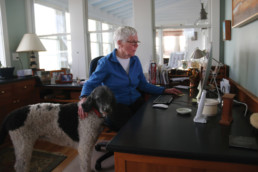
Stranahan at her desk in her Chebeague Island home.
Stranahan attended The College of Wooster in central Ohio, and after graduation, she landed a job at the Cleveland Plain Dealer. Four years later, she was hired by the Philadelphia Inquirer, where she worked as a reporter and editorial writer from 1972 to 2000.
Her beats included the courts and the environment, a focus area for which the executive editor wasn’t initially enthusiastic. “He thought environmentalism was a trend, a fad,” she remembers. That view quickly changed.
Pennsylvania was home to the Three Mile Island nuclear power plant which began operating in 1974. In 1978, Stranahan toured the plant for a story and so knew the basics of how it operated. Then, in March 1979, a nightmare scenario began unfolding.
Early one morning, reporters at the Inquirer’s Harrisburg bureau began hearing police and other emergency responder alerts about an event at the plant, a few miles south of the state capitol. They notified the city editor about what seemed to be problems at TMI. Stranahan happened to be in the nearly empty newsroom when the call landed.
“Based on my one visit, I was the ‘expert,’” she remembers. By mid-afternoon she had become the paper’s point person in the Philadelphia office, ultimately fielding updates from about 40 reporters and photographers covering the developing story and rewriting them into rapidly changing news coverage. What had begun as a local story soon became a global one, with experts warning of a meltdown and the potential spread of radiation over much of central Pennsylvania.
The paper was printing four editions in those days which meant deadlines fell at 6 p.m., 10 p.m., midnight, and 2:30 a.m. Stranahan was anchored to the desk and phone through them all.
“It was really scary,” she recalls. “There was a real fear that the place was going to explode. It was up to us to keep the public informed.”
The Inquirer won a Pulitzer Prize for its coverage of the crisis.
She readily agrees that her career followed the arc of a golden age of newspapers. “The Inquirer was a fabulous place to be, at a fabulous time to be a reporter.” Long investigative projects were encouraged. Great editing was prized.
And there were plenty of fun assignments. She remembers hearing about Canadian wildlife officials airlifting polar bears out of a dump in Manitoba and pitched it to her editor. “Oh, yeah!” was the answer. “Take a photographer!”
After leaving the Inquirer, she taught at the University of Pennsylvania and freelanced, eventually heading to Chebeague to continue working. In 2011, she was asked by the Union of Concerned Scientists to help write Fukushima: The Story of a Nuclear Disaster about the impacts a tsunami had on a power plant in Japan. That wasn’t her first book. She wrote Susquehanna, River of Dreams, about the watershed that feeds the Chesapeake Bay, published in 1993.
“There’s nothing more joyous than writing,” she said.
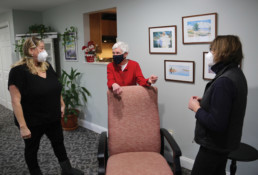
Stranahan, center, at the Island Commons eldercare facility with Amy Rich, administrator, at left, and Nancy Olney, community outreach manager at right inside the facility.
But Stranahan is more interested in talking about her current efforts than in reciting her past successes.
“I grew up in a little town and volunteerism was always a part of your existence,” she said. That ethic is especially important in the small Chebeague Island community. “You owe it to the community to get involved.”
Soon after arriving on the island, she was asked to join the board of the Island Commons, Chebeague’s elderly housing facility, which is licensed for seven residents. It’s been at capacity for several years.
“I was really pleased to be asked,” Stranahan said, despite having no eldercare or even nonprofit experience. It was an opportunity to get to know her new community and to give back, she said.
In 2010 Stranahan joined the board of the Chebeague Transportation Company (CTC) and remains active as a director of the ferry company. She helped CTC win nonprofit status, oversaw the hiring of a full-time general manager, and worked with the board and staff to devise safety protocols throughout the COVID epidemic.
“CTC is Chebeague’s lifeline,” she said.
“Among life-long islanders, there’s a respect for volunteers,” she said, reflecting on her new role. “What keeps the island running 365 days a year is the commitment of its volunteers. It’s something summer people often don’t appreciate fully.”
The Island Commons meets another critical need on Chebeague. About a quarter of year-round residents are over 70, and many have spent their entire lives on the island.
“They are the ones who should be able to live out the rest of their lives on the island with their family,” she says of residents. “They have cooked for community suppers, risen early to start the furnace at church, and established the ferry company. Now they need some assistance,” she said.
“They’d like to stay at home,” but the Commons offers an alternative. The nonprofit also has begun offering in-home care service for the elderly on Chebeague and nearby communities.
The Commons employs 23 full- and part-time staff, which includes a case manager, administrator, outreach coordinator, and caregivers. Stranahan is president of the seven-member board, and she writes grants, appeal letters, and speaks on behalf of the nonprofit.
One of her proudest accomplishments to date is the small resale shop opened a few years ago in an empty building at the Commons. Today, the Red Studio is a popular summer gathering spot on the island, selling donated inventory with all proceeds going to the Commons.
“I never thought I’d find joy refinishing furniture,” she says with a laugh, but it’s another part of what drives Stranahan. “I can help make this place work. It’s nice to be able to give back.”
Tom Groening is editor of Island Journal and The Working Waterfront.
On the Runway and the Gangplank
On the Runway
and the Gangplank
Miss Maine bridges two disparate walks of life
By Jack Sullivan
On Lexie Elston’s first day at her new job, her radio alerted her about a motorcyclist being thrown from his bike. As of that morning, it was her duty to rush to the emergency.
On the rural coast of Maine, it’s not unusual for a marine patrol officer to be first at the scene, and when Elston pulled up in her Department of Marine Resources truck, blue lights flashing, she had arrived before paramedics or police cruisers. As she exited the vehicle, she heard a bystander shout, “Help! Help! Over here.”
“That’s me,” Elston thought to herself. “I’m the help.”
This scenario—which did have a happy ending, as the man was flown to the nearest hospital—was a far cry from the career she pursued as a teenager, one fraught with pressure and drama, though remarkably different.
Elston, now 26, entered the world of pageantry and modeling when she was attending Windham High School.
“When I was in school, I had no time for regular extracurriculars. I wasn’t on any sports teams. My thing was pageants,” she says. At 16, she won Miss Teen Maine United States, and after competing in the 2012 Guess Girl Contest, she began modeling for the brand, widely known for its jeans.
She relocated to Los Angeles and then Miami to pursue that modeling career, which she says was rife with demands and sometimes unkind cracks, such as being accused of having “1980s prom hair.” Elston finally returned home to continue her education and pursue another passion. She enrolled at Southern Maine Community College and earned an associates degree in marine science. She also worked as a park ranger on Mackworth Island and interned for the Maine Center for Coastal Fisheries in Stonington which further fostered her passion for marine biology.
Elston recalls a day in her time on Mackworth when the rangers found baby seals in need of rescue. The marine patrol tended to the helpless seals, and as Elston watched them do their jobs, she realized what direction she wanted to go with her career and signed up to attend the Maine Criminal Justice Academy in Vassalboro.

At the intersection of Elston’s two passions, she found herself modeling on a lobster boat for a shoot with designer Ashley Lauren.
COURTESY of ASHLEYlauren
At the academy, cadets endure a first-hand experience of the pain inflicted by oleoresin capsicum, also known as pepper spray. “It burns so bad, you have no other option but to stand there and freak out,” she says.
There also is the culmination of a cadet’s combat training known as “the final fight,” in which cadets must prove to be physically fit and knowledgeable in self-defense by engaging in hand-to-hand combat with a strong and experienced officer. The cadets have three chances to pass, and should they fail on the third try, they don’t take part in graduation ceremonies.
Elston, in her own words, is not a fighter. Facing a 6-foot, 5-inch-tall, 275-pound man and being pinned under him resulted in two consecutive failures. Feeling more pressure from the third “final fight” than any pageant interview, she emerged victorious.
Soon, she was headed to Jonesport as a new Maine Marine Patrol officer.

“Growing up, I never thought that I would want to be a police officer,” she says. “The number one thing that interests me about the marine patrol is that it’s actively protecting marine resources. I have a passion for the animals. I love the science of them. And the coolest things come up in traps. Little lump fish, starfish, and urchins,” she says with a smile, “and I’m always picking them up and taking pictures of them because I want to share them with the world.”
For those who work on the water—and for those who work in law enforcement—there is no typical day on the job. Elston’s workday depends on the tides and the weather, but more importantly, it depends on the activity on the water.
She routinely boards boats, hauls traps, and inspects gear, but the seasonality of the fisheries makes each time of year a different experience. Sometimes, she finds herself out on the flats checking on clam diggers. Other days, she monitors the scallop harvest. Perhaps the most unpredictable of all her duties is responding to emergencies like search and rescue missions, and, of course, the occasional land-based emergency as well.
Except for her few days off, even when Elston is at home, she is on call. Emergencies in the Gulf of Maine don’t always fall within the 8-hour workday.
“It’s a lifestyle,” she says when describing the work. “There’s no other job quite like it.”
Elston is currently working towards her bachelor’s degree in marine science at the University of Maine in Machias. And she continues to pursue pageantry and does modeling on the side. Since moving back to Maine, she earned the title of Miss Maine in 2019 and competed in Miss Earth in 2022.
She believes her experience in modeling and pageantry continues to give her skills she applies to her work as a marine patrol officer, such as perseverance, which is critical while being nitpicked by pageant judges and modeling agents, and also while working long, physically demanding days on the water.
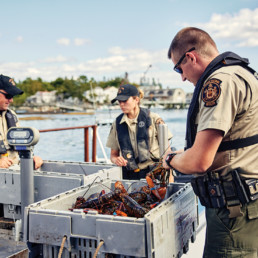
Elston and her fellow marine patrol officers sort through and weigh lobsters. PHOTO: Michael Wilson
Perseverance also proves to be critical for a young woman whose career straddles two different male-dominated fields—law enforcement and science. Elston notes that her experience as a woman in her career is remarkably different from that of a man, but she does find reason to celebrate the incremental growth of female representation. Her 2021 graduating class at the criminal justice academy had more women than any previous year, with 16 of the 67 graduates being women.
“I can be girly,” she says. “I can do my pageantry, and then I can turn around and get pepper sprayed in the face and become a marine patrol officer. Hopefully I can set an example for someone to let them know they can be both of those things.”
Jack Sullivan is the Multimedia Storyteller for the Island Institute.
Climate Activism’s Next Generation
Climate Activism’s Next Generation
At 19, Riley Stevenson has already built working organizations
By Amy Rawn
Riley Stevenson has been busy.
At the age of 19, she has accrued considerable experience working as a climate activist on the Maine coast. Her affiliations include: founder and executive director of the Coastal Youth Climate Coalition, fellow for Maine’s Environmental Education Association, outreach director for Maine Youth Climate Strikes, president of her school’s climate action club, and intern for Rep. Chellie Pingree’s office—an impressive resumé.
But beyond that list, what emerges in conversation with Stevenson is an activist who has been deeply shaped by place. Having moved from New Jersey to Waldoboro with her family at age ten, the pristine and rugged Midcoast coastline was an inspiring new home for a curious middle schooler. A lover of the outdoors and self-described cold-water person, her admiration for her new environment would grow over time into a keen sense of responsibility to contribute to the preservation of this special place.
Stevenson first got her feet wet as a ninth grader participating in a weekend-long program in Lincolnville through the Maine Environmental Change Makers organization. It was her mother’s idea.
“My mom has pointed me towards almost all of my best opportunities,” she says.
It was there that she first became acquainted with the power of organizing and the role of community in shaping our world. She came back feeling empowered to get involved in her own community, and it was not long before she became fully immersed in the work.
“It was such a transformative weekend for me,” she remembers.
After gaining experience working with a state-wide organization, Stevenson felt pulled to make a difference closer to home. This marked the inception of the organization she founded, the Coastal Youth Climate Coalition (CYCC) in December of 2019.
For Stevenson, it was an opportunity to connect young people from Midcoast and Downeast schools who shared similar climate-related challenges. As with any new venture, it took some time to get off the ground.
She describes the early stages of building this group as “emailing into the void,” by reaching out to students at schools along the Midcoast to drum up enthusiasm. After the first three meetings, they had only one participant, but that didn’t last long.
As the pandemic picked up speed in early 2020 and the Zoom malaise had yet to set in, Stevenson saw fellow students looking for connection and eager to participate. Through steady effort, the group expanded. At its height, it had 50 members from multiple schools.
The coalition worked to share knowledge about the climate crisis with other students and hosted lively discussions on articles and books. Their meetings also served as a way to share how to successfully implement climate-related projects in their own schools and communities.
When asked about her proudest accomplishment with the coalition, Stevenson doesn’t hesitate with an answer: Creating a space where people felt comfortable, could pursue their interests, and find community, especially during a challenging time. Another win, she remembers, was a fellow student who joined the group relatively new to climate issues but who has since gone on to major in environmental studies in college.
For Stevenson, the Coastal Youth Climate Coalition was also an opportunity to bring more young people into the fold, especially those from diverse backgrounds that don’t match the stereotypical environmental mold. Part of this effort was the development of her film project, Changing Seas, which highlighted local young fishermen and women, their experiences with the climate crisis, and how those experiences inform their decision-making.
Recognizing a split between environmentalists and those who work on the water—both in her community and at her own high school—Stevenson saw an opportunity to find common ground. The preservation of the coastal environment and its resources in the face of climate change was a shared interest and she seized an opportunity to shine a light on some of the young people who make their living on the water and their valuable contributions to the protection of its resources.
“That outlook has shaped my activism,” she said, the enthusiasm she brings to the work emerging. “How do we bring more people in?”
Throughout her time with the Coastal Youth Climate Coalition she focused on the most effective ways to engage with students, considering how much time they could reasonably commit, and opportunities to use their strengths and accomplish meaningful goals. Burnout and climate anxiety can often creep in, so cultivating an engaged and hopeful community was not just a perk, but essential to the sustainability of both local initiatives and the larger climate movement.
Stevenson recognizes the role that community building plays in successful climate organizing and ultimately the ability to create system-wide change. “CYCC did not solve the world’s climate issue, but it felt really meaningful and it gave me a lot of hope in what felt like kind of a hopeless time. That’s important too,” she says.
Identifying the importance of balance in deterring burnout and acting on some sage advice from a fellow climate activist that “climate can’t be your only hobby,” Stevenson decided to press pause after graduating high school and take a gap year before attending Brown University in the fall of 2022. She’s had the chance to work in Chellie Pingree’s office, spend time off grid in Patagonia, and in her hometown of Waldoboro, where we connected virtually on Zoom—a Maine state flag pinned behind her on her wall.
Before we logged off, Stevenson explained her love of cold water in more depth. She emphatically describes the sense of peace and stillness she finds from the practice of getting into it, overriding what seems like an inevitable reaction to run from discomfort. For her, it has become a way to destress and connect with the landscapes she loves, plunging below the surface of the deep, cold waters of the Gulf of Maine—fully immersed.
Amy Rawn works at the Island Institute as a Marketing Specialist.
Monhegan's Tara Hire: Be Creative, Work Hard
Ask an Islander—Monhegan’s Tara Hire
Island life is not as romantic and idyllic as some would believe
by Tom Groening
Tara Hire of Monhegan Island is one of those people for whom island life seems like an appropriate match. She’s not afraid to step into the important roles that keep an island functioning, such as serving on the town’s board of assessors (similar to a select board), and she’s figured out how to carve out a place to pursue her passion for wellness.
She’s lived on the island full time for 18 years, and navigated changes in jobs—including owning and operating a store and a restaurant—and outside forces like the COVID pandemic. Our conversation was over Zoom in late March. The transcript has been edited for length and clarity.
Island Journal: How did you come to live on the island, and where are you from originally?
Tara Hire: I’m originally from Ohio. I lived there until just after high school and I moved to California, then New York, then back to Ohio. At that point, I was 22. I’d gone back to Ohio to go to college and came to Monhegan in 2000 for a summer job. I graduated from the University of Maine and moved full time to Monhegan in 2004.
IJ: And had you any ties to Maine before that?
Hire: No. I had not even visited Maine before that.
IJ: Interesting. And what was the summer job?
Hire: I worked at the Island Inn as a waitress.
IJ: Did you enjoy that?
Hire: Yeah, it was great. A summer job on Monhegan is especially great when you’re in college. You can make really good money. They have housing for you and supply all your food. So I thought it was fantastic.
You work really hard but then you also have a good amount of time to explore the island, make new friends, and just have a really fun time.
IJ: I’m curious about the housing. I know they often find horrible housing situations for workers on other islands, like Nantucket. Where would they put you up on such a small island?
Hire: They have dorms. The three major hotels have dorms for their staff. And it’s not luxurious by any means. When I came here in 2000, most of us shared a room, and they’re pretty tiny—two twin-sized beds and maybe enough room to walk into the room. You spent most of your time outside.
That’s changed. People have different expectations. They have their own room and a little more space.
Now I have this big, spacious house and rarely go out in the community. (Laughs.) No, I’m kidding.
IJ: How has the pandemic affected island life? It’s been two years now. What would a typical quiet winter be like versus the last two years? I wonder how the pandemic affected you, specifically, and the island.
Hire: My husband and I took it really seriously and so did most of our friends. We haven’t really been as social as we used to be. For the first year-and-a-half, we weren’t going into people’s homes. We would, in the summer, hang out on the deck.
For me, it’s been very dramatically different in my socialization. We still go for walks with people, but just not dinner parties like we would normally do.
IJ: And are you a very extroverted or introverted person?
Hire: I am more introverted, but I like small gatherings.
IJ: For a typical winter, pre-pandemic, did it ever get to the point where, “It’s so lonely here,” or do you savor that?
Hire: I tend to savor it, more so when I was working in the public life. Now I work at home, and I work online. But when I was working in my grocery store and my restaurant, it’s just so intense. You see a lot of people and you interact with a lot of people on a daily basis that it was such a nice relief to have winter. Now, it’s not as much of a relief. Every day is kind of quiet.
IJ: And you ran a grocery store and a restaurant?
Hire: I had a grocery store for seven years. I had a little restaurant before that, for two years.
IJ: You have had a wellness business, teaching yoga?
Hire: Yes, a few years of health coaching, and here on the island, yoga classes and art retreats, some wellness coaching around healthy eating, writing a blog.
IJ: And one of the advantages of having a business like that is that the island is part of the attraction, right?
Hire: Exactly. I was trying to leverage the healing energy of Monhegan and create opportunities for people to be in this beautiful space and treating themselves and learning how to be their best selves.
IJ: So obviously, healthy food is important to you. How do you get your food on the island?
Hire: Our store stays pretty well-stocked and they get vegetable orders weekly. But I also do a lot of shopping online, dry goods like rice and beans.
IJ: How often do you go off-island?
Hire: It ends up being like every six weeks.
IJ: And do you stay overnight on the mainland?
Hire: In the winter, you have to. In the summer, I can do a day trip, but it’s a tight squeeze. It’s possible, but you don’t get a lot done.
IJ: And where do you shop?
Hire: We mostly go to Rockland for shopping and dentist and all the medical. That’s kind of our home base.
IJ: Electric bills have already gone up quite a bit, and you guys already had high electric bills. How do you power your home and heat it?
Hire: We use propane for heat, and we have our own power company here on Monhegan, so that’s our power source. The rates are what they are. They’re high, and you do what you can to conserve. We don’t really go without. Maybe we should, but we don’t (laughs).
IJ: Is it crazy busy in the summer?
Hire: It’s insane in the summertime and people work really, really hard. I might get two days off for the whole summer. Our season is extending on both shoulders. People are coming earlier and leaving later. I think it strains people a little.
We have a little apartment that we rent and there’s people here already, in March.
IJ: I wonder if there’s pent-up demand for travel.
Hire: Monhegan has had banner years for the last couple of years. People are saying they are already booked up—the hotels—for the summer.
IJ: And can I ask about your new job?
Hire: I went back to school and graduated last May with a computer information systems degree. I did an internship with L.L. Bean last summer and was offered a full-time job in August of last year. I’m in the marketing department as a data analyst and it’s great. I love it!
I think the pandemic provided the opportunity for more remote work. They were becoming available but with the pandemic, everyone started hiring remotely. I would have found something working remotely, but it might not have been in Maine, so this is nice.
IJ: What do people who just visit in the summer fail to understand about island life?
Hire: I think in general they tend to over-romanticize island life and think that we are ultra-special, or that we don’t experience the same challenges as everywhere else. When I’ll tell a story about someone not being kind to me on Monhegan, they’ll say, “Even on an island?!” expecting that people would be different here. It’s just not true.
IJ: I don’t want to put words in your mouth, but I suppose you do rely on people more and people help each other out more than in Portland or Boston?
Hire: Maybe. I think a lot of people attracted to islands tend to be more self-sufficient. I can’t say that I rely on anyone else for much, to be honest. That’s one of those misconceptions. People assume we’re all gathering together on a regular basis to hold one another up or helping everyone succeed. And that’s not true. If someone’s in a really bad place and we know about it, we pitch in.
IJ: What sort of friend would you recommend year-round island life to? What sort of person would fit in?
Hire: Someone who is pretty self-sufficient, doesn’t need a lot of social interaction. Someone who’s willing to work really hard and be creative. For 18 years, I had a small business, and I also worked at the museum, I worked at the library in the wintertime. I worked for the town and got a small stipend there. So you have to be willing and able to be flexible in how you make your money.
And after a while it gets old (laughs). I want a real job and I want to know how much money I’m going to make. I want to have health insurance. This is a new experience for me.
IJ: Do you ever think about leaving?
Hire: My husband, Kole Lord, was born and raised here and he’s pretty connected. This is his home.
On a Following Sea
On a Following Sea
By David K. Shipler
Illustrations by Ted Walsh
Sailors once thought sea gods ruled. Poseidon. Neptune. Aegir. Ran. Tangaroa. Now they know the sea has moods. Calm. Peaceful. Troubled. Angry. Mean. But the open ocean shows no sign of caring. It frolics and rages as it chooses, indifferent to fears and pleasures aboard, unconcerned with the vessel, whether of wood or steel or fiberglass, whether beautifully designed with a pedigree or merely riveted and welded for efficiency. Neither polish nor rust affects the force of wind, the height of waves, and the absence of mercy.
The sloop had a pedigree. It was gliding down the long Atlantic swells in a purple dusk. The slender hull, as graceful as a fin, hissed through the water. A classic Pilot 35, built lovingly by Hinckley, treasured by everyone who ever owned one, including their friend’s father, who had asked for a favor. What a favor! The brothers and their friend were helping his father sail northeast from Plymouth to Bar Harbor. The course put the prevailing southwest summer wind at their backs. The swells came from behind. The boat was lifted and lowered by a following sea.
In the early day, gulls that like to hover and prowl around the sand bars and rockweed still wheeled alongside the boat, and terns screeched and dove in frenzied hunts for silver flashes of fish. The boat, named Spray, had not yet sailed far enough offshore to shed the civilization of the coast.
The brothers would take the watch from midnight. In the brief darkness of June they would be lucky enough to witness the enlightenment, that slow dawn revelation of the watery, heaving Earth. For that, it was a prized watch, worth the hours of blind blackness before the expansive spirit gradually opened their seeing.
Nick was always taller, always would be taller, Barry supposed. And firmer in the chest. Muscles bulged when he wore a T-shirt, because he worked out so much down in the damp basement, barbells wrenched from the concrete floor and curling up, then down, sweat staining his shirt despite the coolness down there, adding weighted discs at the end of each stainless bar so that Barry could only struggle to lift one of them, then quickly put it down.
“Don’t strain yourself, kid. It’ll come when you get bigger.”
“I am bigger, and it never comes.”
“I mean really bigger. You’re 14. I’m 20. Besides, I’ve been to ‘Nam. That’s a place where you get bigger really fast. Too fast.” Then his voice trailed off, as every time he’d mention ‘Nam, and his gaze would retreat from seeing something right in front of him to watching some inner thing, it seemed, something in a dream. A bad dream, Barry thought.
“What was it like?” Barry asked occasionally. Nick never really said.
“Hot. Rainy. Lots of bugs. Lots of hot girls in town, near the base.”
“I mean the war.”
“Fuck the war.”
“What was it like? Did you kill anybody?”
“You don’t want to know.”
That’s the way he ended every conversation: You don’t want to know.
Nick seemed different when he came back. The difference seemed too misshapen to measure. Nick didn’t talk as much. He didn’t laugh as much. He didn’t pal around with Barry as much, the way they’d done when they’d pegged a baseball back and forth harder and harder to see who’d give up first, or climb the gnarled apple tree over at Mr. Page’s to see who’d get higher. Or made sling shots together out of perfect forked branches with the bark shaved off and thick rubber bands and leather pouches Nick got from somewhere and see who could fire a stone precisely enough to punch out a window in the abandoned fish plant with a satisfying jangle.
“Don’t tell Mom,” Nick would say, so Barry wouldn’t. But he wanted to—to brag and confess all at once. “Don’t tell Mom and Dad,” Nick said when they climbed around the construction debris down the block and took home a stray box of nails. “Don’t tell.” It made Barry’s neck feel hot.
Nick spent more time alone in his room now, and out back just sitting, looking at the grass and the woods. He sometimes brushed Barry away when he came near, as if solitude were a fortress. Often Nick started, jumped, and ducked when he heard a sound behind him, even just a squirrel rattling in a branch.
He also seemed stuck back in time, as if Barry were still the puny little boy he left behind when he got called up. That was fine when Barry used to need Nick to scowl and grumble at Leon the bully and his bunch who tossed stones at him as he rode his bike, or chanted that he ran like a girl. Nick would saunter over to them and lean down as if he were going to grind them into the dirt and say something like, “You got a problem?” And they would know exactly what he meant. Barry would be home free for the next week or so.
But, hell, he was now 14, “a young man,” his father had said on his birthday. Nick still called him “kid,” which used to mean he loved him and protected him and now meant something else. Barry wasn’t quite sure what, something less fond, more diminishing.
So Barry tried to get on an equal footing and make “young man” talk, if not about the long yesterday of brotherhood and the near yesterday of war, then about today and the near tomorrow.
“What are you going to do after the summer?” he asked Nick. They were sitting out back, where the summer green should have felt soothing. No reply, just an irritated sigh. “Thinking about college? A job?”
“What the fuck do you care?”
Barry’s face burned, like after a slap. He didn’t say anything for long seconds, but then: “Because I care about you, asshole. You’re my brother. I’m interested.”
“Oh, yeah, sorry, kid, sure you are. Well, I’m interested myself, but I don’t have an answer. When I do, you’ll be the first to know.” Then he laughed, but all by himself in a hollow way that people do when they don’t have anything to laugh about.
“I’m going to Stonewood again for six weeks,” said Barry. “It’ll be my fifth year. The sailing’s great, both on the lake and from the harbor. We had a super racing team last year.” Nick said nothing. “Too bad Mom and Dad didn’t find that place when you were young enough to go. You’d have loved it.”
“I had my own sailing camp with the guys around here. They taught me the ropes. Then I taught you a thing or two. I figure someday you might make a good sailor.”
“I’m a good sailor now.”
Nick gave a sharp cluck with his tongue, like a key locking. “Ha. You know the law of the sea? Overconfidence can be fatal.”
“Speaking of fatal, did you lose any buddies over there?”
“You don’t want to know.”
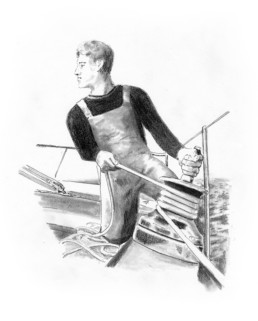
Barry liked the first light when the deep dark was diluted just enough to allow a peek at the coming day. When crystal clarity was promised by the dawn, he got up and waited impatiently for Nick to rise. He’d dropped one little-boy habit—of jumping on Nick’s bed to shake him awake and tease him about being late and wrestling around in cheers of abandon. He knew now he’d get grouched at, maybe even punched on the arm. So he ate cold cereal by himself, watched the brightening through the window, then assaulted Nick as soon as he walked to the bathroom.
“What are you doing today? Maybe we can get Billy and his father and take their boat out for a sail. We’re leaving in ten days, better have a shakedown.”
“Don’t feel like it,” Nick grumped.
“There’s a nice wind coming up this afternoon, ten to 15 southwest.”
“I told you I don’t feel like it.”
“You’re not even awake enough to know what you feel. Dad thinks we need a refresher before heading out.”
“You might need a refresher. I know what I’m doing. Once you know it, you know it. Like riding a bike.”
“Overconfidence,” Barry whispered, then dodged a punch, not a playful one. “Nick, it’s the Gulf of Maine. Offshore. That’s different from bays and coves. We need to learn their boat better.”
“Speak for yourself.” Nick’s back looked iron stiff as he stalked off to his room.
So Barry walked firmly into the rising morning. He took the narrow blacktop road from the house along the gentle slope of dune grass lining the beach. He removed his flip-flops and crossed onto the sand and stopped. “There are two golden hours,” he said aloud. Talking was his habit in aloneness. At times, when he scolded or wondered or coached himself along, or just thought randomly, he mumbled. At other times, sure that nobody was close enough to hear, he orated and declared. Now he lectured the spiraling gulls and whatever sand crabs or jellyfish or other creatures he could not see. “Two golden hours every sunny day, one after dawn, the other before dusk, and here it is. Look at the tint of every surface. Look at the sparkles on the water. A fine day. A fine day for sailing.” Then he kicked a small stone in anger and stomped on an empty crab shell. “The breeze will come up after lunch,” he announced. “Stupid Nick.”
He sat down on the sand to watch the water’s light gain the complicated colors of the morning. “I wish we could be like we were before. No, I wish we could be like we should be now.” He found a thin, flat stone, walked to the lip of the bay, and skidded it sidearm so it skipped 13 times. “Thirteen! All right!” Would Nick believe him?
Barry stood, balanced his stride carefully along the water’s edge, and imagined the lip between sand and sea as the line between now and someday. “Now and someday,” he said aloud. He turned inland through the tall grass and back to the black-top road, ambling on until masts rose from the marina. Since he could remember, and maybe from before that, he had loved to stroll on docks among boats, breathing in the pungent smell of varnish and the sweetness of aging painted wood. The docks stuck out like fingers from a long wharf, harboring sleek power cruisers and dumpy skiffs, sloppy old sailboats and pristine yachts with varnished teak and not a smudge on hulls or decks.
At the final dock, he continued until he could see the dark blue prow, and he imagined her as the afternoon wind would come up, bobbing in her slip, straining restlessly against her lines. He stood by her, inspecting her fore and aft, from the bow pulpit down the foc’s’l past the life raft in the white canister bolted to the deck, the mast that would probe the ocean sky for 50 feet above, the cockpit depressed below the deck to shield from seas and drain away, by hoses down through the hull, whatever spray and breaking waves might come her way.
Billy’s father, older than when he sailed her to the Caribbean for many winters, had fewer ambitions. Just a cruise up to Maine for the summer, that was all. Barry didn’t know why he had so much time on his hands, freeing him for weeks of sailing. It made no difference. When you’re at sea, it doesn’t matter what happens on land.
Ten days later they boarded shortly after dawn, stowing their duffels and packing food and ice behind secured lids and locker doors against the rolling and pitching to come. By 8 they had cast off their lines and eased out of the slip, and then, their diesel engine clattering, motored through the twisting channel and out into the teasing swells of the broad Atlantic, where they hoisted the main, unfurled the jib, and turned northeast into the wilderness.
This moody stretch of ocean is named euphemistically the Gulf of Maine. It is the Atlantic Ocean in all the alluring temptations and caresses and furies that the Atlantic has given sailors since the Vikings piloted their sleek and slender ships through fickle northern latitudes, since American Indians labored their canoes through millennia to outer islands. The Gulf of Maine is nourished by two great rivers in the sea: the Labrador Current, which curls down around Newfoundland and Nova Scotia’s Sable Island to channel frigid water along the Maine coast, and the tepid Gulf Stream, which swoops up and forms a flowing boundary to the south. Caught between the two, the ripping tides roaring down and up the Bay of Fundy stir and thrash. When the Gulf of Maine is tender, it is embracing, like a lush and sunny field. When it is angry, it is primitive. “Respect the water, Barry,” said his camp director, Larney, a browned and brawny man with calloused palms. “Respect the water.”
Barry rode the long rhythm of the swells with keen euphoria, like a symphony’s slow and gentle movement that stirs an eager pulse. The sloop’s 35 feet seemed to shrink and expand at once, tiny yet sheltering, a speck on the vast watery surface and yet an entire enfolding realm. He was conscious of two horizons: the one reaching out to infinity—where on a hazy day like this the blue of the sea and the blue of the sky nearly blended together at the edge of reality—and the one aboard, where a sound vessel drew close limits of comfort and trust.
The voyage would take about 30 hours. First, the day. Then, the night. Finally, the second day whose light before dusk would guide them into safe harbor. They wanted wind, needed wind, to make the timing work.
Nick strutted, Barry noticed. He postured, leaning against the mast with casual ruggedness. But not smoothly, not gracefully while he moved around the boat, as if all his bulging muscles had lost their memory of how to step up and over coaming from the cockpit to the deck and back, of how to winch quickly and how to cleat a line flawlessly. His beefy hands fumbled a little at the winch and cleat, while his manly talk with Billy and his father seemed contrived to cover awkwardness. His balance gave a little as the Spray began to roll and pitch—just a little, not enough to stumble, just enough to make Barry wonder.
Every boat is different, yet the sea treats all boats the same. It plays with them as it wishes, so sailors on whatever craft must learn the cadence of the swells. On the moving deck, Barry was as sure-footed as a dancer. With a magician’s dexterity above the winch, he dropped one, two, three coils of supple rope instantly around the drum, then pulled them tight. As fluid at the cleat as a weaver, he used a single flowing motion to wrap the line in a circle beneath the cleat’s two horns, then crossed it diagonally above, made an opposite diagonal on top, flipped the bight of the rope beneath a third crisscross, secured the clean figure eight with a fourth diagonal and a final circle, and pulled back triumphantly to see if Nick had seen.
He had. He tilted his head just a little and raised one eyebrow, a talent Barry envied.
The first hours at sea are always eager hours, the crew jaunty, the boat liberated and lively in the waves. The gleaming black fins of dolphins now and again above the surface made them point and shout. They peered hard in search of smoky wisps of spray that might mean spouts of whales. Rotating jobs, they settled slowly into the pace of the morning, then midday. The following breeze barely tickled the back of Barry’s neck.
Nick was supposed to tend the jib but wasn’t watching the flutter, the luff. “Can you come in with the jib?” Barry asked from the helm. Nick gave him a quick glare, glanced at the sail as if seeking evidence to rebut the request—the command. But then shrugged, grabbed the winch handle, and gave a defiant half turn. “A little more?” Barry said.
“It’s fine,” Nick growled.
“No, another turn or two,” said Billy’s father. Nick spun the handle twice around, rapidly to show his strength. The jib, now taut as a white bird’s giant wing, flew high without the hint of tremor. Nick shot Barry another glare, then whispered to him below the threshold of the rushing sea and wind, “It was good enough for government work. We’re not racing, you know. Don’t stress.”
Barry’s smallness did not feel as feathery as usual. His steering on the wide, spoked stainless wheel came instinctively, without the labor of thinking. The morning haze had cleared, the wind was steady now off the starboard quarter in a comfortable broad reach, the Spray’s favorite tack. The following waves nudged the boat to the right and left off her heading as the stern was pushed gently to port by the waves behind, then to starboard in the troughs. A good helmsman finds a complementary tempo, leaning and turning the wheel left, then right, then left to hold the boat on course in sympathy with the following swells. So it was with Barry, somewhat to his surprise, his small body tuned to a simple reflex as he rode the wheel and the rising seas.
And rising they were. Spelling one another on the helm, the crew allowed their talk to ebb throughout the afternoon. One by one, they went below to nap in expectation of their coming watches in the night. Above, the water’s cobalt blue mellowed, the sun began its slow decline over their shoulders. The wind speed on the gauge grew gradually to 18, 20. Gusts made it jump higher and higher in brief bursts, as if playing with limits. And the wind backed around until it was blowing from directly aft, making a run that forced them to sail wing and wing, the main out to starboard now, the jib to port, the stern lifting higher and higher with every surging wave, then sliding into every trough with a hiss of foam. The seas were building behind them. The boat was surfing down the steepening waves. Steering grew more difficult.
“Who wants to set the boom preventer?” Billy’s father asked, looking straight at Nick—the biggest of the lot, the most muscular, the daring combat soldier who had faced a lot more danger than this. But Nick looked down, then away at the seas. Foam was blowing off the crests. The boat was leaping. Billy, leaning into the wheel, struggled to turn the bow down the steepening slopes to keep her from sliding sideways recklessly into the valleys of the waves. There were no other candidates. Billy, straining against seasickness? Barry, as slight as a matchstick in the hum of wind? Billy’s aging father with shaky balance?
“At sea, no problem goes unsolved,” Larney had once told the boys around the campfire, “or it could be the last problem that you’ll ever have to solve.” The slow, weathered voice drifted into Barry’s memory along with the low whistle of the wind in the shrouds. Larney’s tales of the Pacific had the boys crouching forward toward the flame-flickering reflections of a face jagged in the night. The thick eyebrows, like grey ridges, cast his sunken eye sockets into ravines of such shadow that the little light finding his eyes made them glint impishly as he told his sea stories—tales, they knew, that would always come out well.
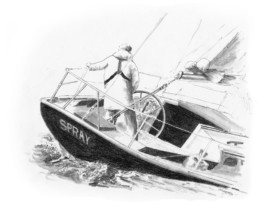
The mainsail on a run in a wild sea was a problem to be solved. The boom, far out to starboard to catch the following wind, swung dangerously aft again and again as the rollers lifted the stern and spun the boat this way and that. A wave tossed the stern left and put the wind to starboard, the mainsail went slightly slack, the boom reeled toward the stern, and then as the stern lurched to the right, away from the wind, the boom swerved sharply back to starboard until it was snapped to a stop by the braided rope of the mainsheet. Every time, the mainsheet twanged out tensely. Nobody worried that the line would break. It still had the pliability of newness, showed no chafe, and was threaded back and forth four times through stainless steel blocks. But the hardware might be in question: the shackles, the cotter and clovis pins, the swivels. Hidden corrosion could make them fail, and when a critical piece of steel gave way, Larney had told the boys, the sound was like a gunshot. All this Barry remembered as he braced himself in the bucking cockpit, marveling at the shocking blue and white of the Gulf of Maine.
The near jibes were not good for the sails. As the boat rolled and yawed, the mainsail lost wind, and so did the jib. Then they would snap full again, luff, then snap, luff, then snap. And if in its swinging, the heavy aluminum boom ever reached amidships close to the stern, and the wind caught the sail from the opposite side, the boom would jibe and roar across to port with enough force to test the strongest rigging. All four of this crew could imagine the worst, which is what you have to do at sea. It could rip out the bolts holding chain plates to the deck, and since the wire stays from deck to high on the mast were held taut by those plates, any failure would transform a stay into a loose and lethal cable swirling like a whip against all else aboard, metal, fiberglass, and flesh.
The problem had a solution, as Barry also knew from racing small boats. But here on this wildly frolicking ocean, this ocean that hadn’t even yet turned mean, it was a risky solution to perform. Step out of the protected cockpit, up on the adjacent narrow deck, work your way forward to the boom, staying low so a jibing boom would pass over your head, not into it. Move to the foot of the mast and grab the small lanyard on the pin of the snap shackle that held one end of the block and tackle—the boom vang—whose other end was fastened to the bottom of the boom. Pull the lanyard on the pin to open the shackle, then step to the starboard gunwale, the very edge of the boat, the edge of the world of safety, feed the hook of the shackle through the oval stainless ring secured there, and click it closed. Then pull hard on the bitter end of the line through the blocks until the boom vang, now converted into a boom preventer, was tight enough to keep the boom from swinging aft.
“Whose gonna set the preventer?” Billy’s father asked again, looking straight at Nick. But Nick did not meet his eye. He pretended to busy himself at a winch, tending the jib sheet. Silence in the shoosh of foam and wind.
“OK, I’ll do it,” Barry finally shouted and waved toward the bow. “Somebody take the helm. Nick?”
Nick leapt for the security of the wheel, grabbed its cold curve of shining steel, jostled Barry out of the way like the linebacker he used to be, and held on as if the helm were a sanctuary. But instead of riding with the following sea, he wrestled against it. He spun the wheel too far to starboard, too far to port, the stern flung itself back and forth, the main sail fluttered for a moment as the boom swung dangerously, then snapped full as the boom careened back to its proper place. Barry eyed the frantic deck he was to navigate.
“Let me,” said Billy’s father. “We don’t want to dump your brother overboard when he goes forward.” The man, trying to laugh, stepped up and over the cockpit benches to the wheel and steadied it with a practiced grip. Nick gave a stricken look as he stood aside. In the father’s hands, the Spray quickly settled into a rhythm, lifting, falling, rolling, yawing in a predictable tempo that felt reassuring—a small boat’s harmony with a following sea.
“No!” Nick yelled to Barry. “I’ll go, kid. Stay here, safe and sound. I got it.”
“Harness,” said Billy’s father. Nick wormed his way into the webbed belt and shoulder straps, secured one end of a tether to the immense buckle at his belly, and clipped the other to a jack line of cable they had rigged for just such an occasion. Shackled in the cockpit, the wire ran along the deck to the forward most cleat at the bow. Nick clipped himself in and stepped out of the cockpit onto the narrow deck.
“Stay low,” commanded Billy’s father. “At least one hand on the boat at all times.”
That was all very well, Barry thought, but Nick would need two hands to pull open the little shackle holding the boom preventer’s block to the mast, and probably two hands to close the shackle around the ring on the gunwale. Why the hell didn’t we do this before, when it was calmer? Larney’s voice again: Act when the idea first enters your mind, don’t wait. Reef the main as soon as it occurs to you. Rig the boom preventer whenever you’re sailing on a run and the seas build.
Nick crawled. Barry thought he must have done that in Vietnam, snaking along the ground, bullets whizzing overhead. Belly down, Nick stopped halfway to the mast and turned to look back at the cockpit. Yes. His eyes were frozen wide the way dead people look in movies before somebody thoughtfully touches their eyelids closed.
He took forever to reach the foot of the mast, and then he hugged it with both arms. He had no hands left to manipulate the shackle. The boat was trying to hurl him. At last he released one arm, fiddled with just one hand but couldn’t pull the pin. Again he hugged the mast. Again he glanced back at the crew in the cockpit with a paralyzed look.
“I’ve got to go help him!” shouted Barry. The father didn’t say no, he just said, “Harness.”
Out of the shelter of the cockpit and higher on deck on the way to the mast, Barry felt more fragile surrounded by the ocean’s boiling temper. He gripped the rail of varnished teak handholds, affectionately maintained for the aesthetic tastes of fair-weather cruisers. A tiny revelation stung him with amusement: that the gleaming brightwork he admired was absurdly precious here, against the sea’s indifference.
At the base of the mast, he touched Nick’s shoulder and felt an arm grip around him. “Hey, kid, what are you doing here? But thanks for dropping by.” Barry waited for a steep roll and pitch to pass, then reached both hands for the shackle, pulled on the little lanyard to yank open the pin, clutched the detached pulley to his chest, and—using one hand again to hold desperately the gloriously varnished rail—wriggled down to the narrow lower deck to reach for the silvery ring.
Funny how strange thoughts wisped through his head, like spindrift blowing from the crests of breaking waves. The ring, the eye nut, marked the farthest edge of his life. Just beyond, over the gunwale, roared the mounting anger of the following sea. And the Spray was trying mightily to toss him as casually as a bronco might flick a cowboy. His tether would not keep him aboard; it was long enough that he would merely be prevented, once in the water, from drifting away. In fact, as he knew from Larney’s tales, he would be slammed against the hull again and again and would survive only if his shipmates were quick enough in hoisting him back up to their refuge, which was bobbing and twirling like a toy. He saw Nick still above, now crawling back toward the cockpit.
A wave crowned over the stern, sending green water swirling up the deck and bathing Barry in iciness, curiously refreshing. He rolled toward the horizon, then back inboard, and reached through foamy chaos with both hands on the shackle, fed its hook through the eye nut, clipped it closed, and pulled hard on the rope through the pulley, holding it like a lifeline as he backed down and tumbled over the coaming into the safety of the cockpit.
A cheer went up in celebration. Nick slapped him on the back and gave him a long look that Barry had never quite seen from him before.
Meals at sea were kept simple. A pot of chili heated on the stove, ladled into bowls, wolfed down while bracing against the tossing, pitching, rolling, every muscle active in the struggle—the beautiful struggle, in Barry’s mind. He felt at one with the boat, like a rider attuned to a galloping horse. He wanted to inhale the lingering twilight, to keep the enchantment inside him.
The ocean darkened. “Come on, kid,” Nick ordered, “let’s get some sleep before our watch. So you don’t fall asleep on the wheel!” But who could leave the canopy of stars that floated above them, the embracing belt of the Milky Way, the wind whistling in the shrouds, the whisper of the water past the hull? “Come on, kid. I don’t want a guy with me who can’t hold his own.”
Sleep did not come easily, but it came. Every lurch, every blunt knock of wave against the hull, every slap of halyard on the mast above, every call from Billy or his father to haul in or loosen, to watch a distant set of running lights that might mean a vessel trawling—every one of those little alarms would have shot a pulse of tension through a skipper’s shallow sleep and had him nearly on his feet and topside. For a while, Barry lay rigidly in his sleeping bag, listening to all the sounds as tightly as a skipper would. But he was not the skipper, and eventually he drifted off.
A hand shook his shoulder. “Midnight,” said a voice, kindly and perhaps apologetically. Barry did not yet know a fact about this moment: It was never pure pleasure to wake the next watch, but not a regret either. It was one of those cruel duties, which, for anyone with both self-interest and a heart, brought an odd mixture of relief and sympathy.
He pulled on a slicker, rain pants, and boots against the spray and the heavy dew of the night. He buckled on his harness, wedged his shoulder against the rolling companionway for balance, and climbed the three-step ladder out of the compartment and into the wild. The air hit his face joyfully, fresh and damp. The stars were whirling above, the sails ghostly in a shallow moonlight, the running light atop the mast twisting back forth against the Milky Way like a firefly.
Nick was there already, tense. Billy’s father gave the course, reminded them to mark their position on the paper chart below every hour, and pointed slightly aft to fuzzy lights way off, appearing and disappearing behind the waves. “Fisherman. We passed him. Nothing else around.”
“Sleep well,” Nick said, a note of false bravado in his voice. Billy and his father disappeared below, slid the hatch closed, and sealed the brothers into the long struggle of the midwatch.
The wind still came roughly from behind. Barry blinked in alarm at the glowing digits showing the speed. What had been a steady 20, 25 in daylight now held at 35, 37, and—a second or two after a gust made the rigging scream—the number jumped to 40, 42. The seas had swollen, too. In the dim light, he had to look up to see the crests of the waves, which chased them and curled with teasing menace at the stern. The boat careened, forcing every muscle to work without pause.
Barry began the watch at the wheel, riding the bucking hull by bending one knee, then the other, to stand upright while the boat rolled back and forth beneath him. In the same tempo, he turned the wheel left and right, steadying the boat on course, holding the stern from being flung too far in one direction or the other, catching the rhythm—and crowing with delight as the sloop was lifted by a steep wave and surfed down the forward slope like a skier on a dangerous run.
“This is great!” he shouted. “What fun, eh?”
Nick stared back, said nothing, gripped the coaming with one hand, a winch with the other, and braced himself in the corner of the cockpit. He did not join in his brother’s yelps of joy at the invigorating splashes of spray. He did watch Barry closely, though, as the boy negotiated a treacherous labyrinth on this following sea.
They agreed on an hour at a time on the helm, to spell each other. That was quickly reduced to thirty minutes, such was the strain of steering. They had planned to talk, at least Barry had, the way men talk on watch at night in the bare ocean, bereft of worldly distractions. Some sailors say the midwatch is like a priesthood, just the purity of faith with no temptations. A time for godly reflection and, when not alone, companionship.
But they were silent. Barry tried a few times. “Having fun?”
“Oh, yeah, sure.”
“Ever seen the ocean like this?”
“Nope.”
“Remember that squall we got caught in with Uncle Don?”
“Nope.”
“You remember. In Buzzard’s Bay. We saw the blackest clouds, and you could see the rain like dirty streaks slanting down. And then the thunder. Remember?”
“Oh, yeah, and Uncle Don wouldn’t turn back.”
“It was too late. We were too far out. We just prayed it wouldn’t hit us.”
“But it did. Well, not the lightning. We saw that far off. Thank God. Lightning on a boat.”
“Yeah, lightning on a boat. Not fun. But this is fun, no?”
Nick seemed to open his mouth to start to say, “No.” But he didn’t.
It was his turn on the helm. Again, he fought the wheel. The boat nearly broached, shuddering down the steep cliff of a wave as the stern was thrown sideways across the seas, Nick’s spin of the wheel a bit too late, a bit too much, and in the wrong direction. The bow always tries to head into the wind, and the rudder sometimes loses its bight. The Spray heeled sharply to starboard, pitching Barry off the port bench onto the cockpit deck. “Shit!” he yelled.
“What the fuck!” Nick’s eyes were as wind-swept as the sea. His knuckles were stone white on the wheel. His knees stiffened.
“How the fuck do you do it?” he shouted to Barry. “Is there a fucking trick to this?”
The hatch slid open, and the sleep-weary face of Billy’s father peered out. “That was something. Everything OK?”
Nick froze. Barry covered. “Yeah, just a rogue wave. No damage. All is well.”
“Hang in there, boys. Call if you need help.” The face disappeared, the hatch slid closed.
It’s odd that time matters so much atop the timeless sea. Even in the ages before GPS satellites sent timed signals to receivers and electronic charts, sailors using the stars and sun to fix latitude and longitude needed precise chronometers aboard. And whoever has stood watch in a gale or a wintry night knows how often the hour is checked, and how slowly it advances toward the time when the watch ends and the relief takes the deck.
That consciousness of time intruded. It stained the perfect wilderness of star-strewn sky and ocean. What better place to be suspended in the present? Yet Barry couldn’t keep from glancing at his wrist, as Nick did his, to see how long they had to go. A trace of sadness came with the countdown, for Barry especially was riding gracefully with the following sea and looking forward to the very first light of dawn, which would come just before they were to go below.
Nick’s pleading look from behind the wrenching wheel moved Barry to scramble up from the cockpit deck where the near breach had thrown him, and crouch his way to the helm. “I’ll stand in front of you,” he shouted over the wind to Nick. “I’m short enough, you can see over me. You keep your hands on the wheel, and so will I. I’ll help you judge the turns.” There was just enough room for them to stand behind the wheel, both facing forward, Barry’s back to Nick’s chest.
Nick said nothing, but he let Barry in and wrapped his arms around Barry’s shoulders to the cold curve of stainless steel. With two pairs of hands, and Barry’s leading, the wheel made its quarter turns right, then left, then right in perfect rhythm with the sea. The stern was lifted, dropped, swung, beaten, taking green water that found every flaw in every seam of every piece of foul weather gear until they were both shivering.
“I think I’m getting it,” Nick finally said. And yes, his hands gradually applied more force, and more, until Barry was nearly following without guiding. “Where the fuck did you learn this?” Nick asked.
Barry shrugged. “We had some rough weather at camp. You get the feel of it. See? Aren’t you getting the feel of it?”
“Sort of, but don’t take your hands off the wheel, buddy.” Barry could feel him trembling, which he thought must be from being soaked and cold. Perhaps.
There is no place on earth like the open ocean to witness the elemental beginning of a day. It arrives so quietly at first that it seems to be playing inside the searching thoughts of wishfulness. Barry felt it in his chest, a buoyant rush of faith. The whirling stars grew less vivid. The waves lost some darkness. A tossing horizon emerged and rocked like a faint line, beckoning. Foam lightened into frothy whiteness. The sails caught the slightest hint of blue, then pink. The air was easier to breathe. In the expanding view of vastness, the waves looked smaller and less menacing than in the night’s imagination. The Spray was sailing nearly into the sunrise.
Four o’clock. Time to wake Billy and his father. The brothers lingered for a few minutes, taking in the pastel dawn. They turned and looked closely at each other, suspended for a while on the surface of the sea. No thoughts were spoken. Their watch was over.
At sea it doesn’t matter what happens on land, true, yet on land it sometimes matters what has happened at sea. Land has more gravity, it seems, which pull things back toward what they always were. But not all the way back.
David K. Shipler, a Pulitzer Prize-winning author, is a summer resident of Swan’s Island who has sailed in the Gulf of Maine aboard his sloop, Windward, for 35 years.
The Illustrator's Island
The Illustrator’s Island
Peaks Island is sanctuary for narrative art
Story By Carl Little
Photos by Claire Dibble
Brigadoon. Twice during conversation on a February morning, illustrator Scott Nash compared the residency program he and his wife, artist Nancy Gibson-Nash, set up on Peaks Island to that mythical Scottish village. True, the five or so-minute drive from the ferry terminal to the north end of the island—we took the scenic route—gives you a sense you are slipping the chains of civilization.
Yet arriving at Tolman Heights and entering the spacious new art studio there, you realize the place is very real and very welcoming.
This summer marks six years since Nash stood before the island’s Trefethen-Evergreen Improvement Association to share some ideas he had about illustration. Reticent to blow his own horn—his illustrating bona fides are well-known—he decided to try out a few pie-in-the-sky projects. In retrospect Nash chuckles at some of his schemes, including a line of artisan word-based rugs. When he began describing a school for illustrators on Peaks, ears perked up.
Referencing Monhegan’s famous summer art colony and such programs as the renowned Black Mountain College in North Carolina, Nash talked about bringing illustrators, narrative artists, and writers to the island, with complementary exhibitions and workshops offered to the community, which would include Portland.
His and Nancy’s vision of a school without buildings shifted when Peaks Island resident John Faison approached them with the offer of a site to start a residency program. Faison had been looking for a way to honor his late wife Marilyn and suggested his Tolman Heights property might serve as a haven for illustrators.
Around a century earlier the place had been a bohemian enclave, so the vibe seemed right. The original development, owned by Frederick T. Whitney, a wealthy Bostonian, featured a variety of structures, including a house built from New Hampshire stones and a 75-foot-tall observation tower erected, it is said, so the owner could see Mount Washington on a clear day (remnants of the latter remain).
Nash and Gibson-Nash mulled over the offer and came up with a vision of a sanctuary where artists working in illustration, animation, cartooning, graphic novels, and other narrative arts could work, recreate—do whatever they wanted to do.
Faison offered the original stone cottage and a four-bedroom guest house to serve as lodging. The couple launched the nonprofit Illustration Institute in 2016 with “Picture This…,” an exhibition of 17 contemporary illustrators at the Portland Public Library. The residency began the following summer.
Nancy remembers one of the first responses to their invitation to come to the island: “Hell, yeah!” Since then, around 80 artists have made their temporary homes on Peaks; there would have been more but for COVID (the 2020 season was cancelled). Participants are allowed to bring a spouse or a friend, their children, and even their pets, which has added to the community feel of the residency. The one- and two-week residencies run from May to September.

Scott Nash and Nancy Gibson-Nash, founders of the Illustration Institute.
From the start the program has been invitation-only. Nash and Gibson-Nash work closely with the Illustration Institute’s advisors, many of them esteemed illustrators, who make recommendations, as do resident artists. Once the list is finalized, they put out a general inquiry to the chosen artists.
Nash, who has been an educator for most of his professional life—he started the illustration department at the Maine College of Art and Design—is astonished by the generosity. “To have somebody like [New Yorker cartoonist] Emily Flake come here and give a three-hour workshop-talk on creating a single-panel cartoon is astonishing to me.” After that session, one of his former students said that it was one of the best experiences he had ever had, including his time at MECAD. “My nose got out of joint for a moment and then I realized, how brilliant is that,” Nash recalls.
The artists also have given back through the work they have created while on the island. Writer and editor Martha White worked on the book On Democracy, a collection of her grandfather E. B. White’s essays that was published in 2019. Children’s book illustrator Lizzy Rockwell came up with the idea for How Do You Feel?, a picture book that introduces youngsters to a range of emotions, and made a set of sketches during her residency in 2018. After her publisher gave her the green light, she returned to Peaks in 2021 to work on the final book. She is now sharing it in schools across the country.
Nash and Gibson-Nash take pride in the Institute’s role as incubator. “A thing that didn’t exist is now out in the world,” says Nancy.
A number of residents have returned to Peaks, as island-struck as their hosts. Nash mentions the renowned Argentinian cartoonist Ricardo Liniers Siri, who goes by Liniers, who first came in 2018 and returned to vacation on Peaks in 2021. New Yorker cartoonist Flake has been back a couple of times.
“They’re starting to talk about this being a place that is friendly to artists, that this is the place to be,” Scott says. What is more, says Nancy, “The idea of being at a residency on the coast of Maine is irresistible to artists all over the world.”
Nash and Gibson-Nash came to Maine in 2001, in essence to reconnect with their creative selves. Scott had a highly successful graphic design firm in the Boston area that had grown to three divisions with 80 employees, plus a spin-off, Big Blue Dot, where he developed designs for kids, a passion of his.
“You start building a company and then you realize as an artist that you’re doing more managing than creating,” he says.
The couple had friends in Portland and on visits they looked around at houses. One day, Nancy’s friend Marianne Lloyd, who had worked at Big Blue Dot, took her on a bike ride around Peaks Island. Halfway around she was wondering to herself, “What is this place?” She and Scott had grown up on Cape Cod and missed being near the water.
“I came home and told Scott, ‘We need to move to an island,’” a proposal he greeted with some reluctance. “If we’re going to move to a new place, I want to be in Portland,” he said, but his spouse “cast a spell” on him and when he recovered, they were at a closing on a Peaks Island home. “Honestly, Nancy was right,” Scott says: “I’ve never felt more connected to the community, the community here and in Portland.”
Part of the attraction of Peaks and Portland was the creative community they represented and how welcoming everyone was. And then there was the amazing line-up of illustrators on the island, among them, Doug Smith, Cynthia Jabar, Jamie Hogan, Marty Braun, Kevin Hawkes, and the late Tim Nihoff, all acclaimed for their children’s books and other narrative art.
“It certainly made me feel like I was at home,” says Scott, and he and Nancy soon got to thinking, “Well, this is an illustrator’s island.”
And it’s an illustrator’s state: The Institute has welcomed a host of well-known Maine-based picture book artists to the island, including Chris Van Dusen, Ashley Bryan, Kevin Hawkes, and Melissa Sweet. Crime novelist Brenda Buchanan and playwright Elizabeth Peavey have also found a writing refuge on Peaks.
And what of their own creative endeavors? With two assistants and an engaged board, the couple have been responsible for the program from the start. Somehow, they have managed to maintain their personal artist practices while managing the institute.
“To be honest,” says Nancy, “while the nonprofit is a full-time labor of love, it also constantly ‘fills the well’ for me personally.” To have the chance to be exposed to artists they admire and learn about their artistic process “has been nothing short of amazing and spurs the imagination in profound ways.”
The Institute’s exhibitions have also proved inspiring. She has had work in several of them, including a devilish-looking typewriter in “Illustrated Monsters by Monster Illustrators” and a “crazy couch” in “The Art of Mending.” The latter, a collaboration with illustrator Kate Gardiner, took her passion for found objects to a larger scale “and practical purpose”: The couch now resides in the library at Mechanics Hall in Portland.
Scott, too, draws on the energy of the resident artists. One of the side benefits of interacting with them is “gaining their insights and learning that many of us lead crazy, multi-gigged lives.”
He is currently writing two illustrated novels for kids and illustrating another, Bunny and Clyde, written by Megan McDonald. He continues to do graphic design through the NASHBOX studio in Portland and has returned to directing video production and animation through the Institute’s Drawing Is Thinking and Art & Story series.

Scott Nash at the drawing board
The work of the Institute helps address a “trope” that has driven Scott nuts his entire professional career: that illustration is not art. He points to one of Garth Williams’s drawings for George Selden’s classic The Cricket in Times Square as an example of the genius they hope to convey about the art of illustrating, how in tune it is with the narrative and makes it whole. The Institute organized an exhibition of Williams’s illustrations at the Portland Public Library in 2019. Says Scott, “We want these artists to be recognized.”
Their next show is “The Great State of Illustration in Maine” at the Brick Store Museum in Kennebunk in the fall, which will feature such celebrated illustrators as Ashley Bryan, Daniel Minter, and Dahlov Ipcar.
Looking forward, Nash and Gibson-Nash want to deepen the Institute’s connection to the greater Peaks Island community. Maybe it’s more programs in the off season; maybe it’s additional residencies.
The Illustration Institute is evolving, says Scott, and he and his wife have been letting things happen more or less organically. “We didn’t have a grand mission statement,” he says, “but we are responding to how the artists and the community connect to what we’re doing.” He and Nancy find that arrangement “absolutely liberating and fascinating.”
For more on the Illustration Institute, visit www.illustrationinstitute.org.
Carl Little is the author of many art books, including The Art of Monhegan Island and monographs on Dahlov Ipcar, Mary Alice Treworgy, Eric Hopkins, William Irvine, Joel Babb, and Irene Olivieri. In 2021 the Dorothea and Leo Rabkin Foundation honored him with a Lifetime Achievement Award for his art writing. Little’s essay “Memorable Meals or How My Mother’s Manicotti Saved the Day” appears in Breaking Bread: Essays from New England on Food, Hunger, and Family. He and his brother David are working on their fourth collaboration, Paintings of Penobscot Bay (Islandport Press).
When the Irish Invaded Canada
Image courtesy of the Universal History Archive
When the Irish Invaded Canada
Fenian Brotherhood, with members from Vinalhaven, planned to seize Campobello
by Christopher Klein
Less than a year after Robert E. Lee relinquished his sword at Appomattox Court House, a band of battle-hungry Mainers boarded a steamship in Portland. Armed with revolvers and Bowie knives, the volunteer soldiers had no intentions of traveling south to reignite the Civil War. Instead, the Irish immigrants sailed Downeast on a most fantastical mission to use the islands of Passamaquoddy Bay as steppingstones to liberate their homeland an ocean away.
To the Irish revolutionaries who departed Casco Bay in the first week of April 1866, glimpses of the Atlantic surf pounding Maine’s untamed coastline stirred warm memories of the Emerald Isle, which had been Great Britain’s unwilling colony for seven centuries. In a quest to recast the Irish in their own image, the British attempted to extinguish Ireland’s culture, language, and religion, and when the island’s potato crop failed in 1845, some Irish thought the British were trying to exterminate them altogether.
The Great Hunger claimed approximately one million lives and forced another two million Irish to abandon the island. Refugees who settled in Maine found work in the lumber mills of Bangor, the textile factories of Lewiston, the shipyards of Portland, and the quarries around Penobscot Bay. Forever scarred by the horrors of the Great Hunger, many of these exiles would always consider themselves Irish first, American second.
The most militant of these Irish Americans enlisted in the Fenian Brotherhood, a revolutionary organization founded in 1858 by John O’Mahony, a leader of the failed 1848 Young Ireland rebellion. Using the proceeds of war bonds that would be payable with 6% interest six months after the establishment of the Irish Republic, O’Mahony’s group purchased weapons that it planned to ship to its sister organization, the Irish Republican Brotherhood, to wield against the British in Ireland.
As the Civil War drew to a close, the Irish who cut and carved stones on the Fox Islands formed Maine’s first Fenian chapter in Vinalhaven. In the days following Abraham Lincoln’s assassination, Fenian recruiter and future Boston mayor Patrick A. Collins whistle-stopped through Maine and formed new chapters in Bath, Augusta, Bangor, Lewiston, Portland, Waterville, and Biddeford.
Along with the Fenian Brotherhood’s exponential growth, however, came a widening schism. While O’Mahony wished to stay true to the original, long-term objective of attacking British forces in Ireland, a breakaway group led by William Roberts sought more immediate action by striking the British Empire at its nearest point—the colony of Canada.
Few Irishmen in New York City had a less enjoyable St. Patrick’s Day in 1866 than O’Mahony. As Irish revelers paraded through the streets, he grappled with his soul inside a Manhattan brownstone that served as Fenian headquarters. With his faction losing headlines and donations to the Roberts wing, O’Mahony felt the organization he had carefully nurtured slipping from his grasp.
Although only a week earlier he had proclaimed that “the men who propose to invade Canada have no right to call themselves Fenians,” an anguished O’Mahony reluctantly changed course and approved a plan to seize Campobello Island, which sat in Canadian waters across a narrow channel from the far eastern corner of Maine. The plot was the brainchild of Fenian treasury secretary Bernard Doran Killian, who asserted that a quick strike would pre-empt the northern invasion planned by Roberts and allow O’Mahony to regain his place at the vanguard of the revolutionary movement.
The Irish-born Killian argued that the Fenians could use Campobello Island, which provided sanctuary for British loyalists and traitor Benedict Arnold’s vast smuggling enterprise after the American Revolution, as a base from which to launch an invasion of Ireland and gain belligerent status to legally issue letters of marquee to privateers who could disrupt British sea trade.
In Killian’s wildest dreams, the attack could spark an Anglo-American war as the U.S. looked northward to fulfill its Manifest Destiny.
O’Mahony put his treasury secretary in charge of the expedition, although he had no experience in commanding an army. Before sailing to Maine separately, Killian supervised the loading of the Fenian arsenal onto a barely seaworthy vessel that belonged to the Confederacy before the Irishmen bought it at auction from the U.S. Customs Service.
On April 6, “General” Killian and the first wave of Fenian soldiers disembarked in Eastport, the nearest American city to Ireland, with plans to strike Campobello Island the following day. The plan’s mastermind discovered to his disappointment, however, that the craft with the Fenian weapons hadn’t arrived—but British defenses had.
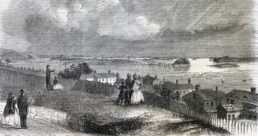
Bystanders watch as British naval units arrive in Eastport Bay, the scene of the Fenian Demonstration. Sketch by A.C. Warren / Courtesy of Dickinson College
“No news travels so freely or so fast as the ‘secret’ doings of the Fenian Brotherhood,” quipped Mark Twain. “In solemn whisperings in the dead of night they secretly plan a Canadian raid, and publish it in the World next morning.” Indeed, the New York World and rival newspapers had printed every detail of the Fenian deployment to Maine.
Within days of O’Mahony’s approval of the Campobello venture, British authorities knew all about it since the Fenian leader’s close confidant, James McDermott, was selling secrets to the British consul in New York. When O’Mahony learned that the campaign’s secrecy had been compromised, he ordered the Fenian ship with Killian’s guns to return to New York and stopped several hundred Boston Fenians from traveling to the border.
Forced to postpone the attack until a rented schooner arrived from Portland with other Fenian muskets, Killian spent several awkward days lodging in the same hotel as British detectives and a U.S. marshal. Amid the delay, two British warships and thousands of British and New Brunswick troops arrived in Passamaquoddy Bay.
Tired of dawdling their days away, one group of restless Fenians decided to finally breach the border. Near midnight on April 14, nine Irishmen lowered in a boat from a Fenian privateer and rowed with muffled oars right beneath the nose of the HMS Pylades.
After landing on Indian Island, sandwiched between Eastport and Campobello Island, the Fenians rapped on the door of the British customs house and demanded possession of the Union Jack flying over it, which the deputy customs collector readily surrendered. Satisfied with their war trophy, the Fenians departed the island in triumph without causing any damage or firing a single shot.
Days after the midnight game of “capture the flag,” the Fenian schooner from Portland finally arrived, but the 129 cases of arms aboard were seized by American forces now led by Major General George Meade, who had been dispatched to Eastport by Secretary of War Edwin Stanton and Lieutenant-General Ulysses S. Grant to enforce American neutrality laws.
In a last-ditch effort to convince Meade to release custody of the guns, Killian told one heck of a fish tale. He claimed the hundreds of Irishmen loitering around Eastport were on a fishing excursion and needed the muskets and carbines to protect themselves against over-aggressive Canadian anglers. Meade didn’t bite. Devoid of weapons and money, Killian abandoned his post and sailed home to New York.
Although their general had departed, the Fenians remaining in Eastport did not give up the fight. Under the cover of darkness on April 20, a raiding party again landed on Indian Island. This time they torched four buildings, including a British customs warehouse. Ironically, the attack inflicted the most damage on fellow Americans as the Fenian inferno consumed two stores owned by a pair of Eastport residents.
Two nights later, dozens of Fenians hijacked a schooner and directed the captain to set sail for Campobello Island. Although they didn’t elicit a response from an artillery company from South Portland’s Fort Preble encamped on Treat Island, the Irishmen roused the attention of British warships that forced a hasty retreat to American soil.
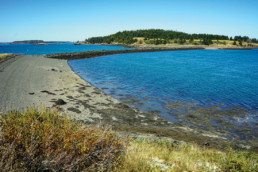
Treat Island, looking north from Dudley Island with Eastport in the distance. Treat Island is adjacent to Campobello Island and the Canadian border. PHOTO: Tom Groening
With Passamaquoddy Bay locked down by both American and British forces, the discouraged Fenians followed Killian’s lead and returned home. The venture dubbed the “Eastport fizzle” by critics cost the Fenian Brotherhood $26,000 and O’Mahony his leadership post. The Fenian founder had contradicted his long-held belief and had nothing to show for it except ridicule—and one captured Union Jack.
While the Downeast fiasco was worthy of a comic opera, an invasion of Ontario by the Roberts wing weeks later turned deadly serious as more than a dozen men perished when the Fenians defeated Canadian defense forces at the Battle of Ridgeway. The triumph proved short-lived, however, as the Fenians were forced to retreat when American forces cut their supply lines.
In a strange twist of history, the Eastport expedition indeed helped to bring self-government to a British colony—just not the one the Irishmen intended. The Fenian menace on the southern border highlighted the benefits of a confederation of Canadian provinces for the region’s self-defense, and previously controversial pro-confederation measures passed decisively in both New Brunswick and Nova Scotia in the weeks following the Fenian foray. A little more than a year later, the first Canadian parliament convened in Ottawa, thanks in part to the Irish shenanigans in Passamaquoddy Bay.
Christopher Klein is the author of four books, including When the Irish Invaded Canada: The Incredible True Story of the Civil War Veterans Who Fought for Ireland’s Freedom and The Boston Harbor Islands: Discovering the City’s Hidden Shores. His history stories have appeared in the Boston Globe, the New York Times, and History.com, the website of the History Channel. Learn more at www.christopherklein.com.


